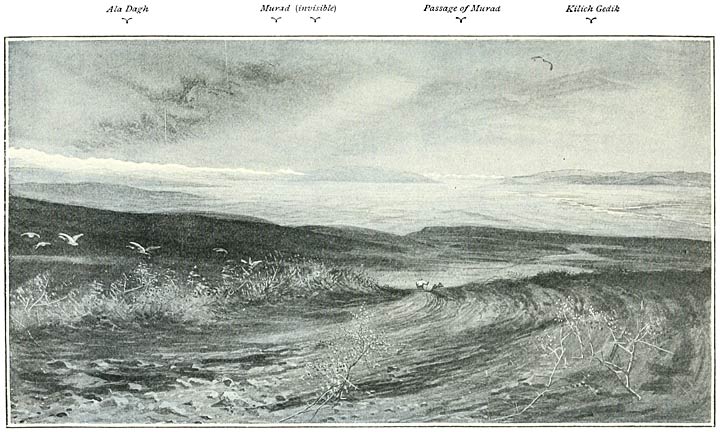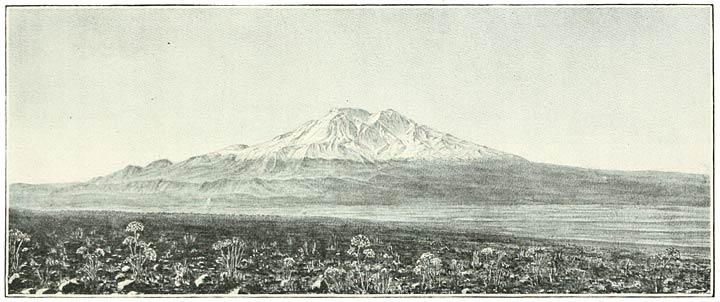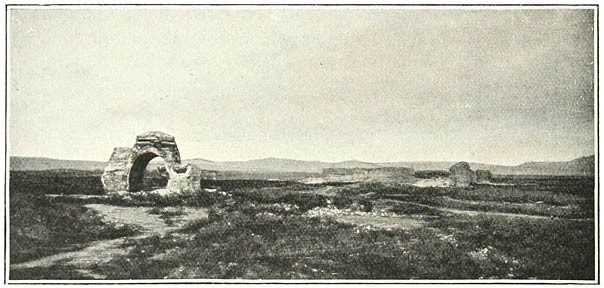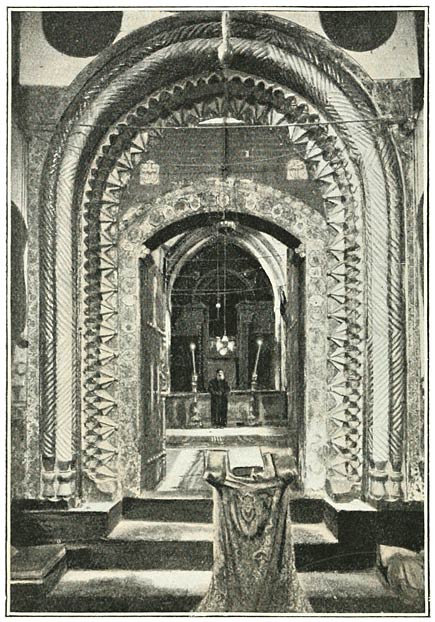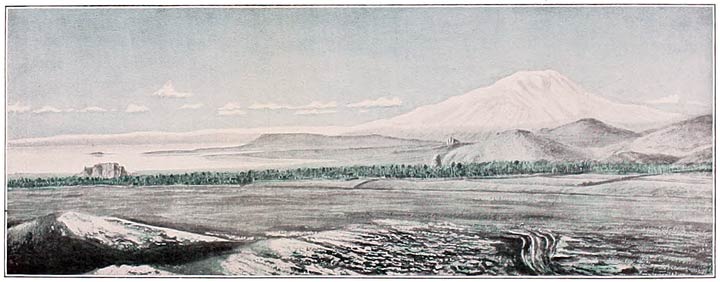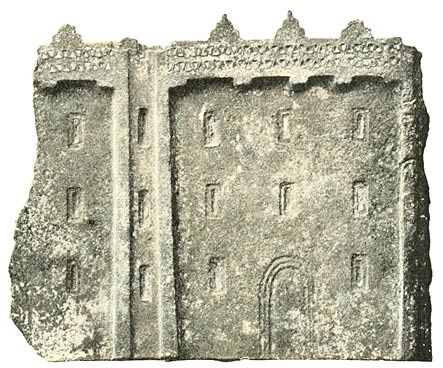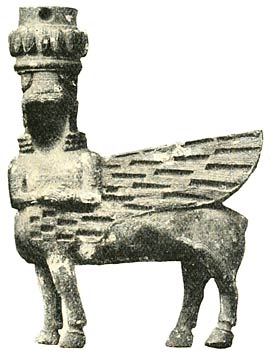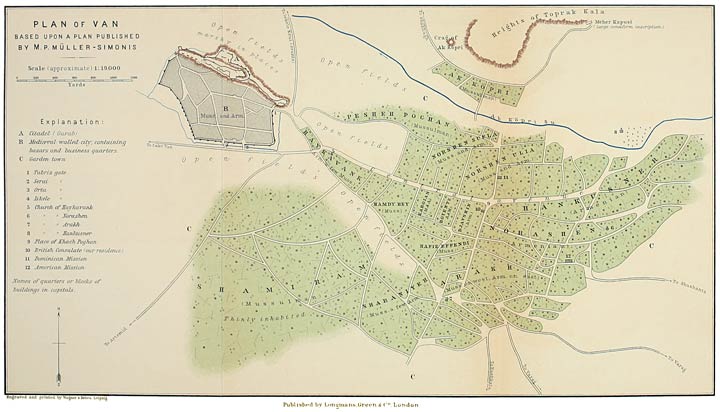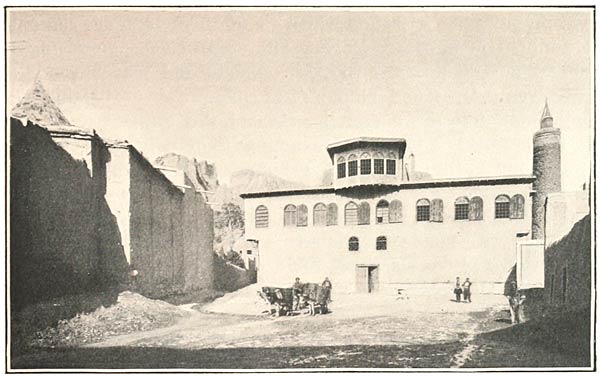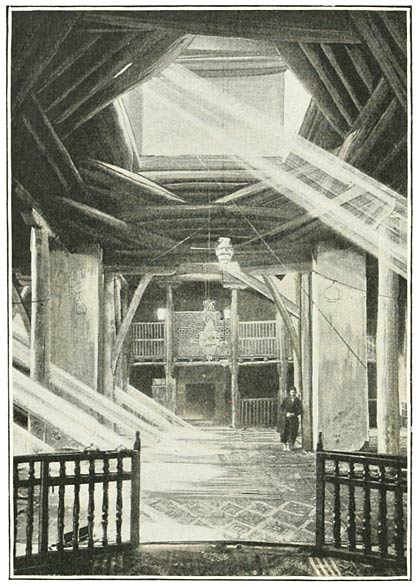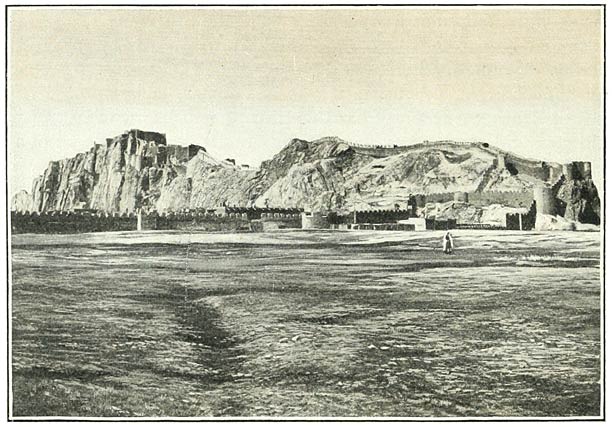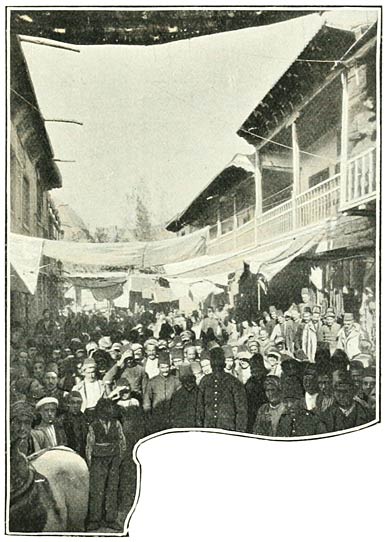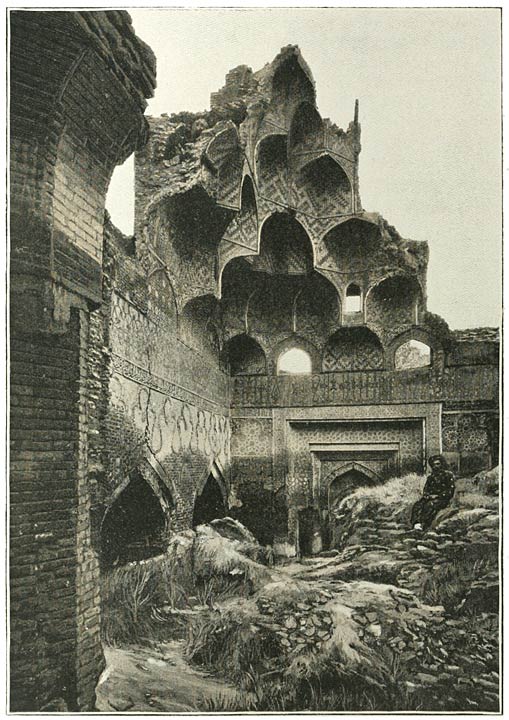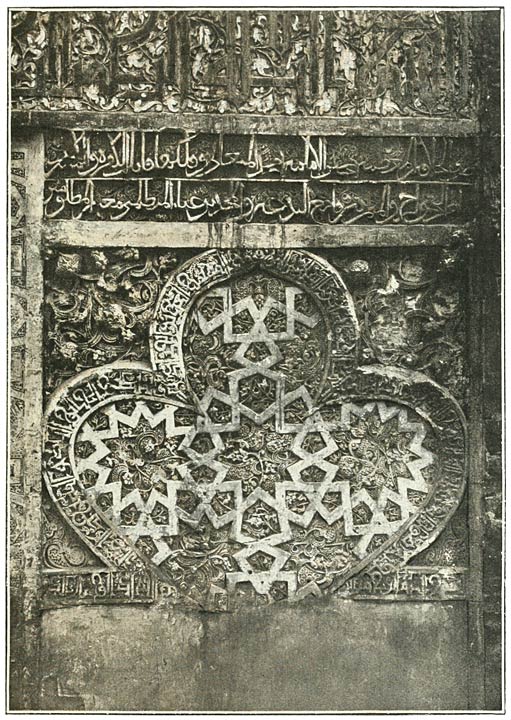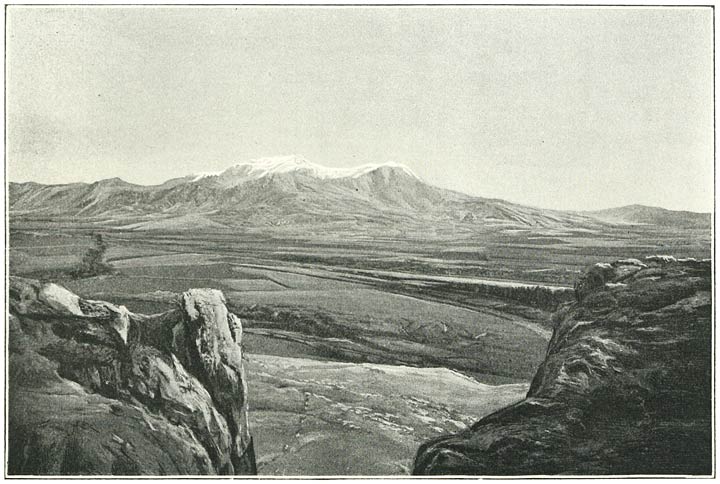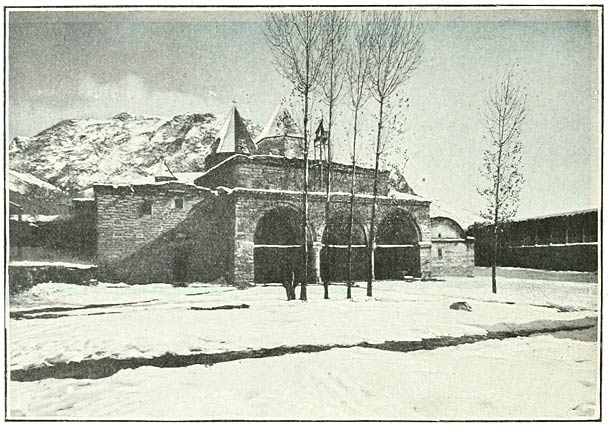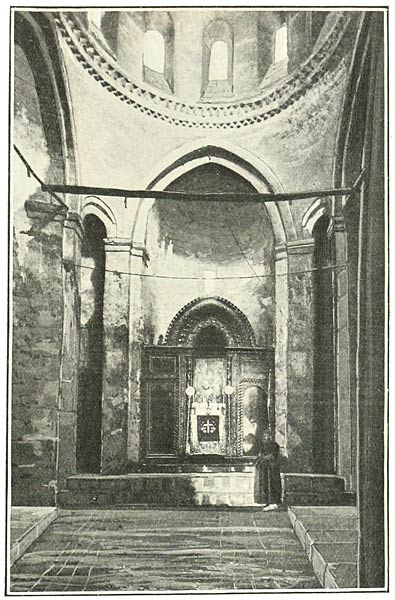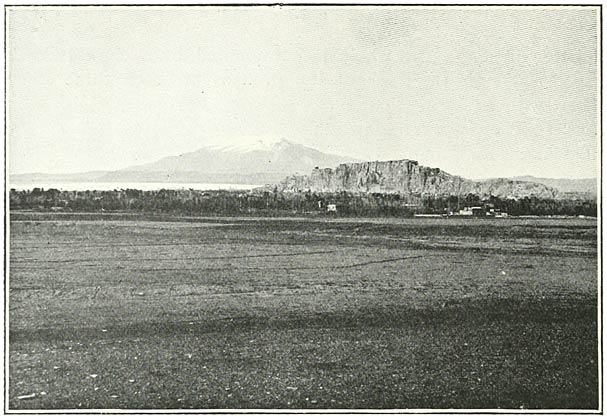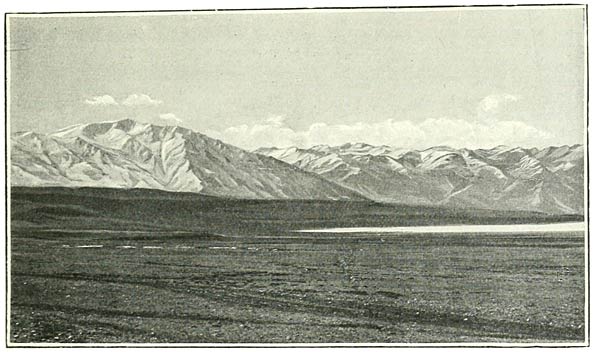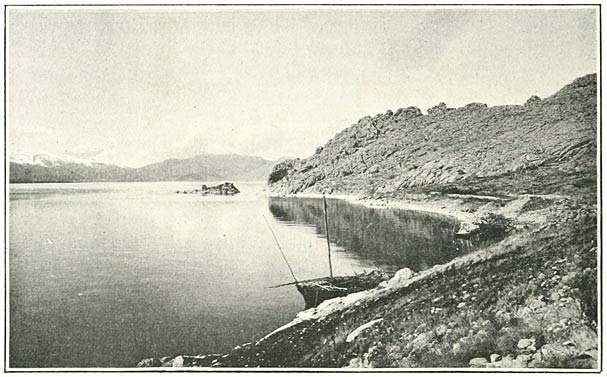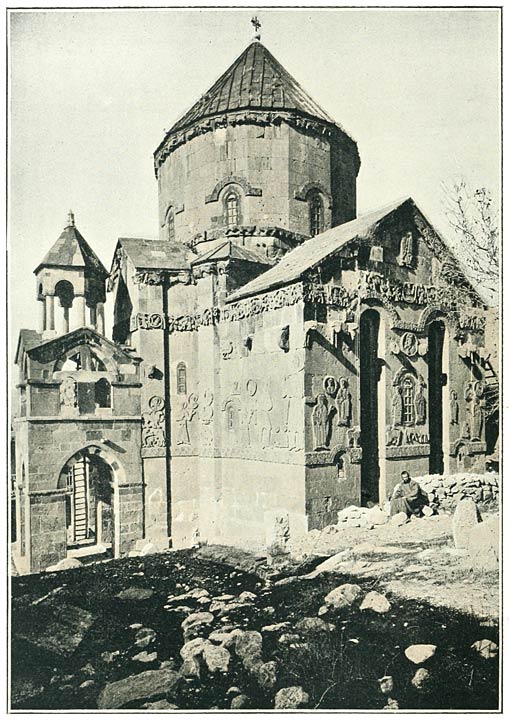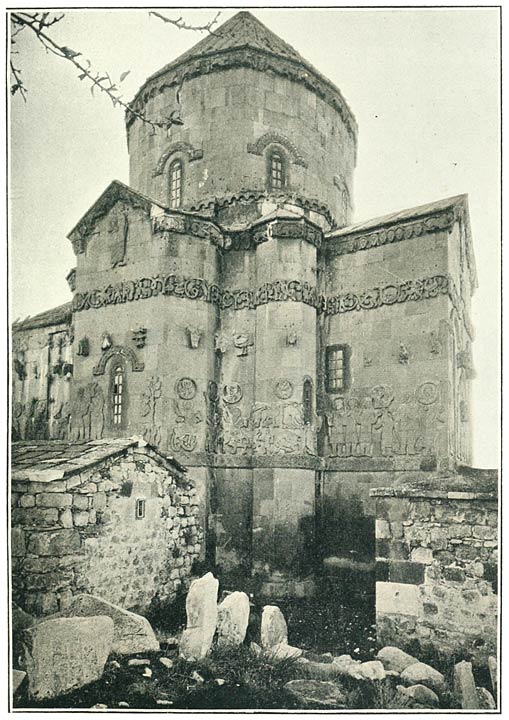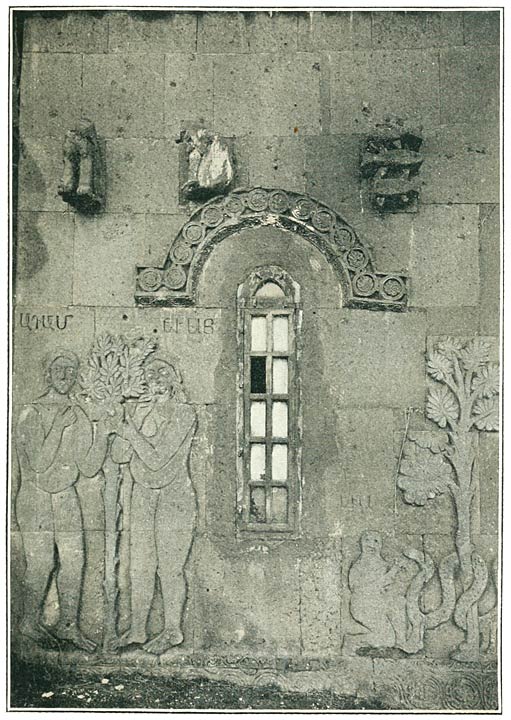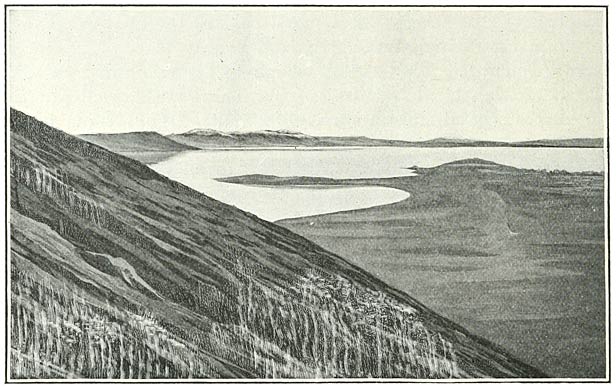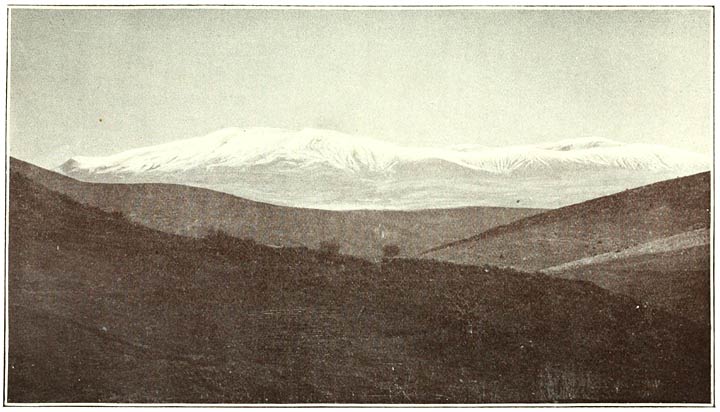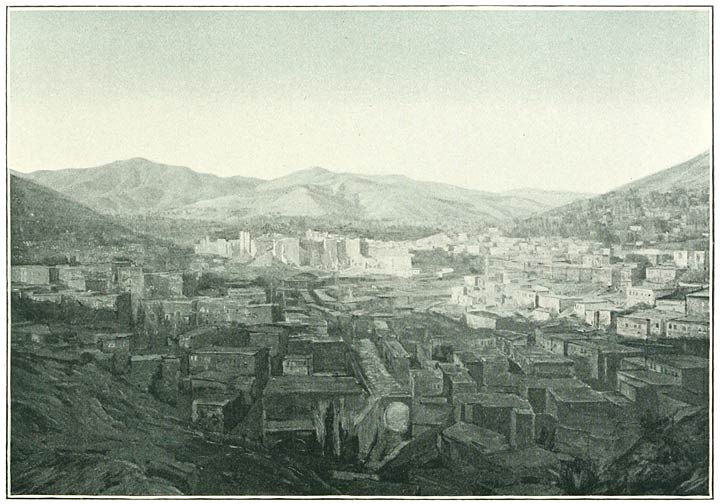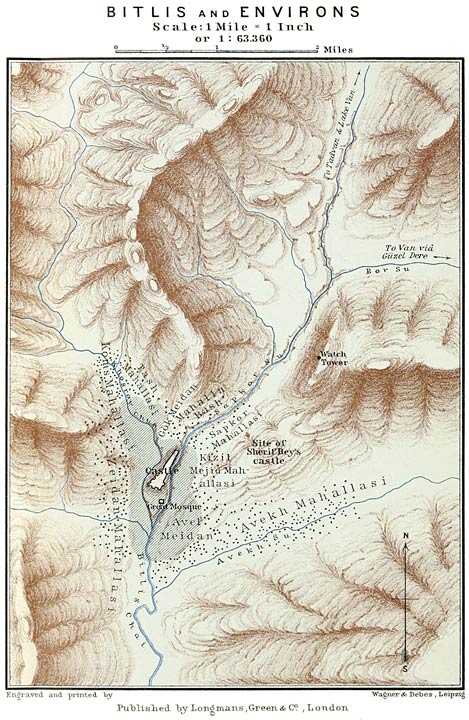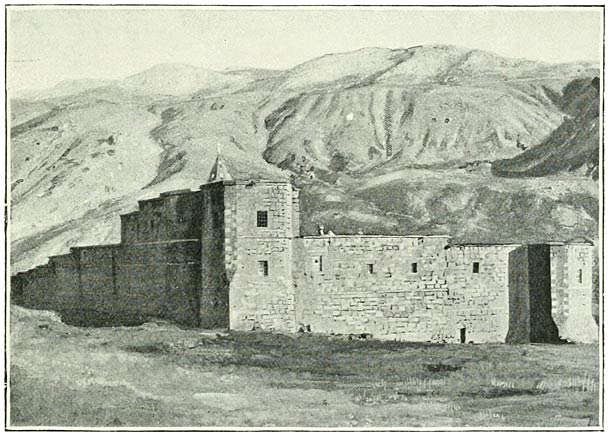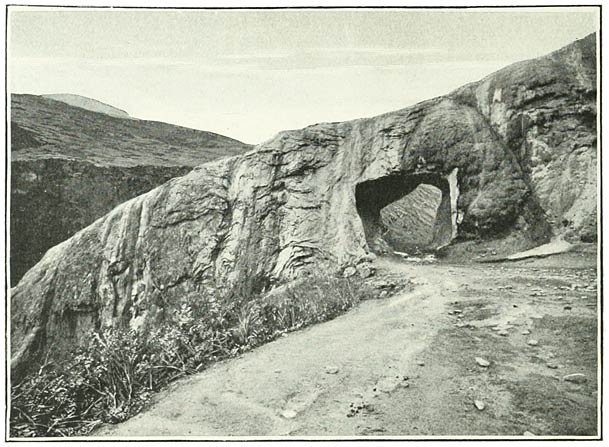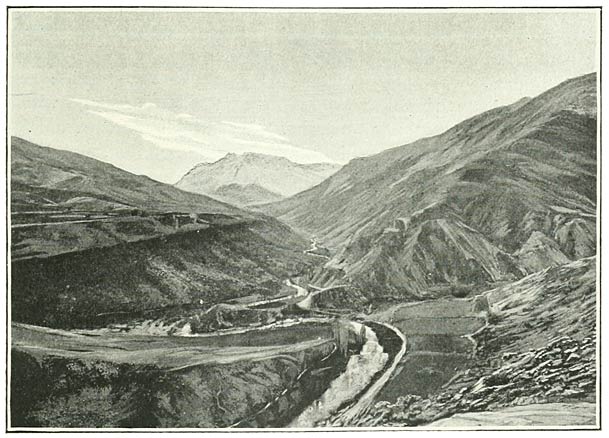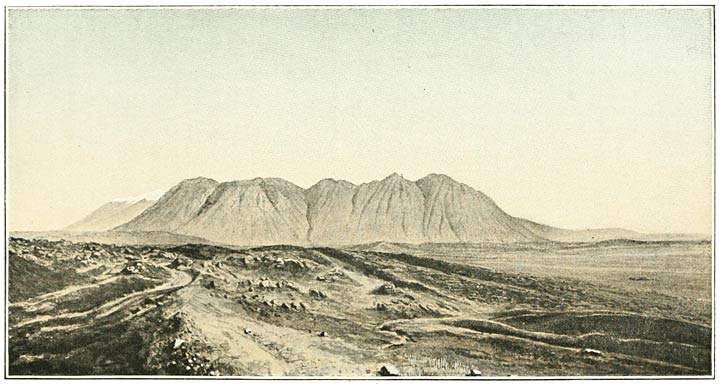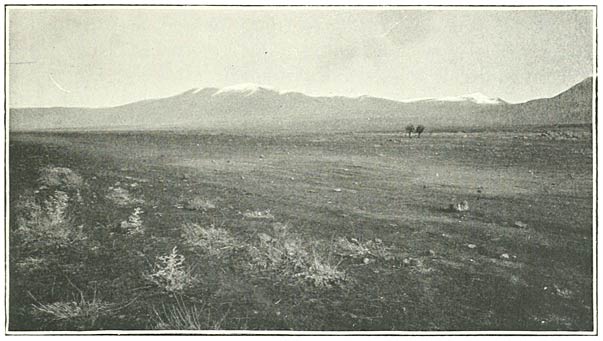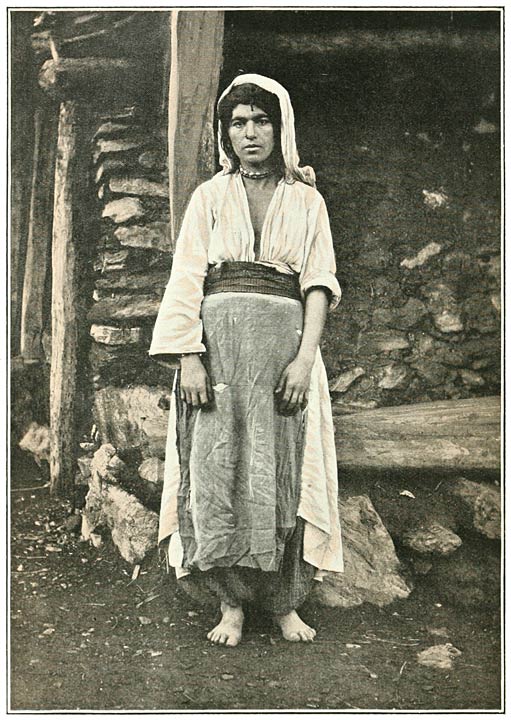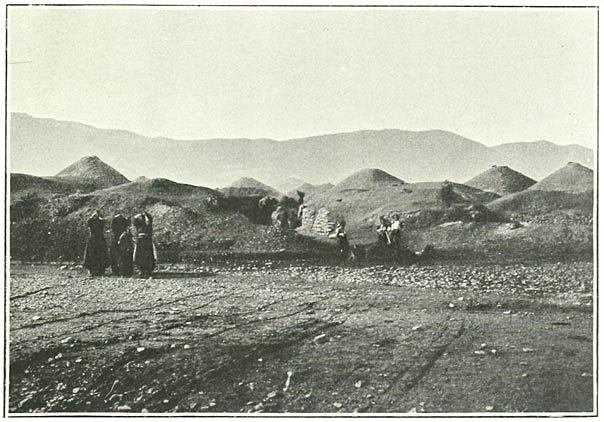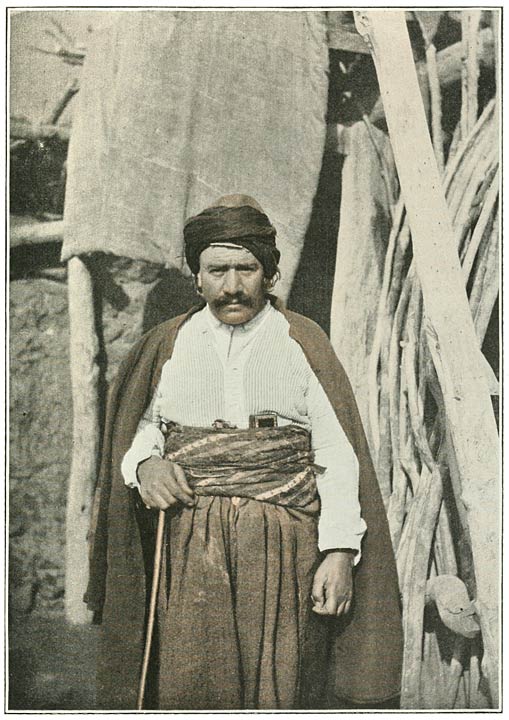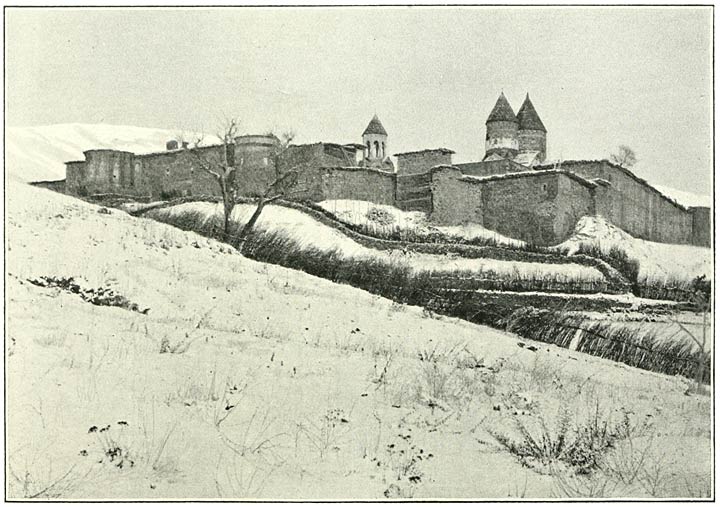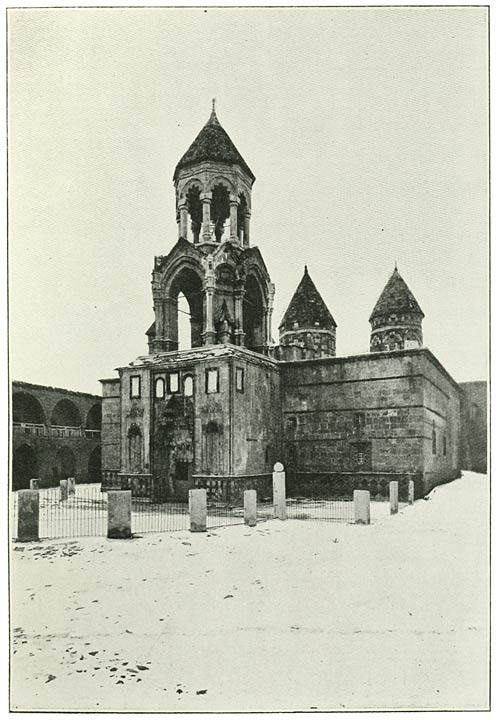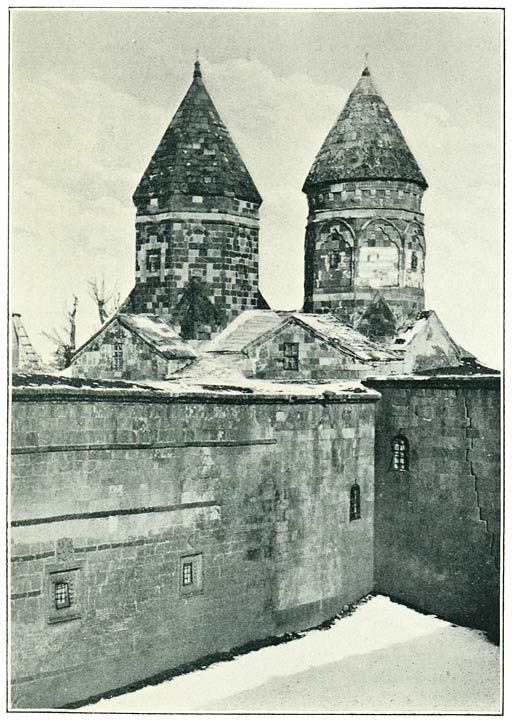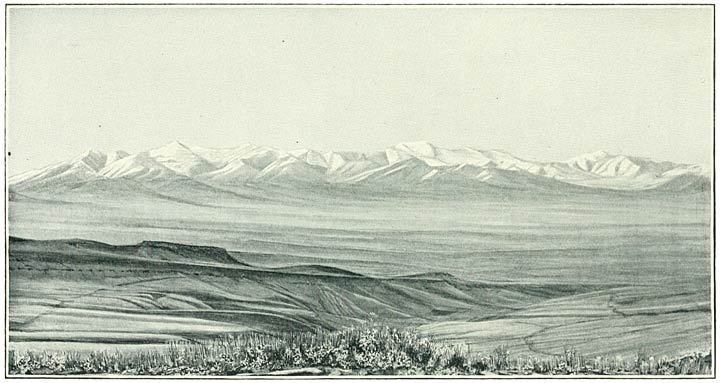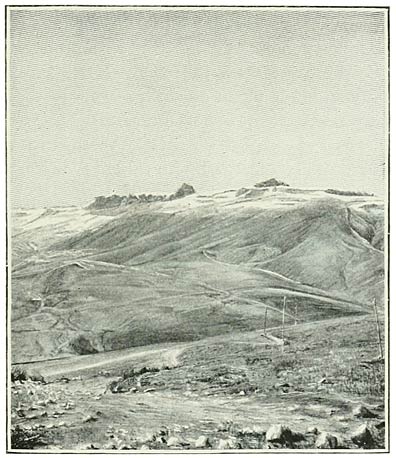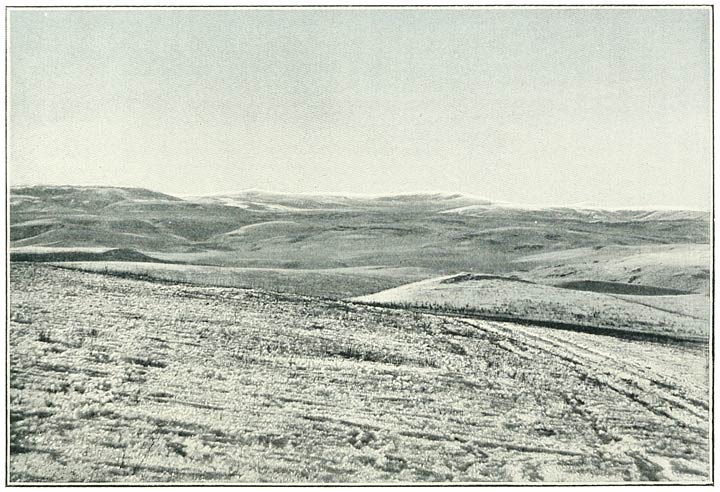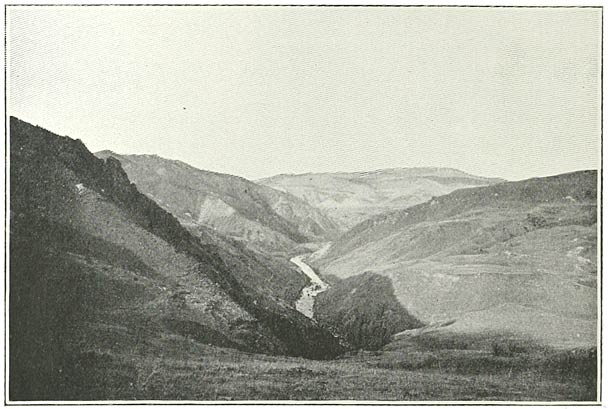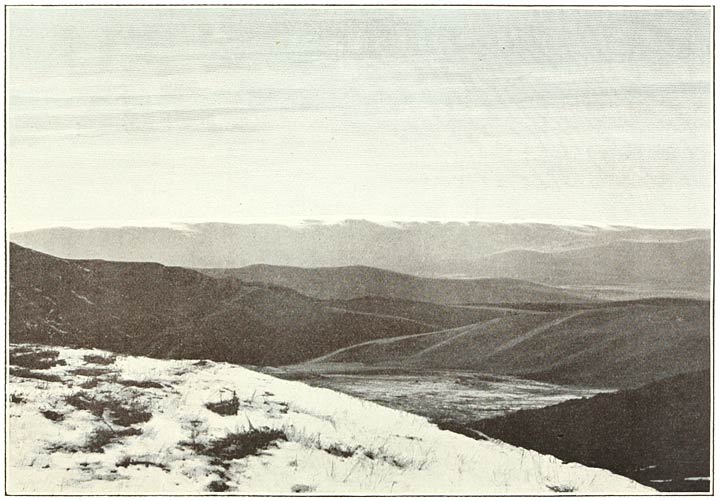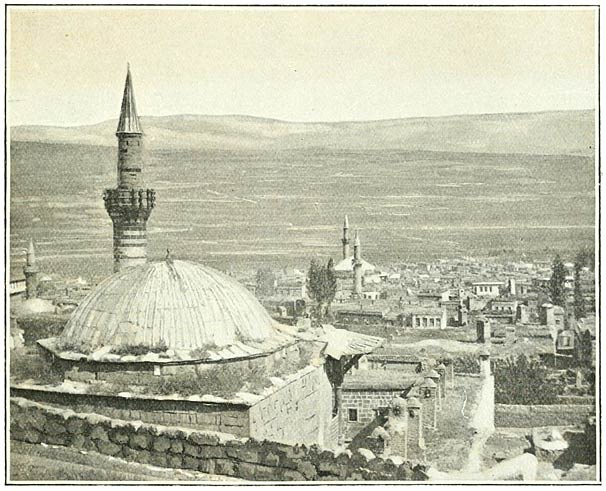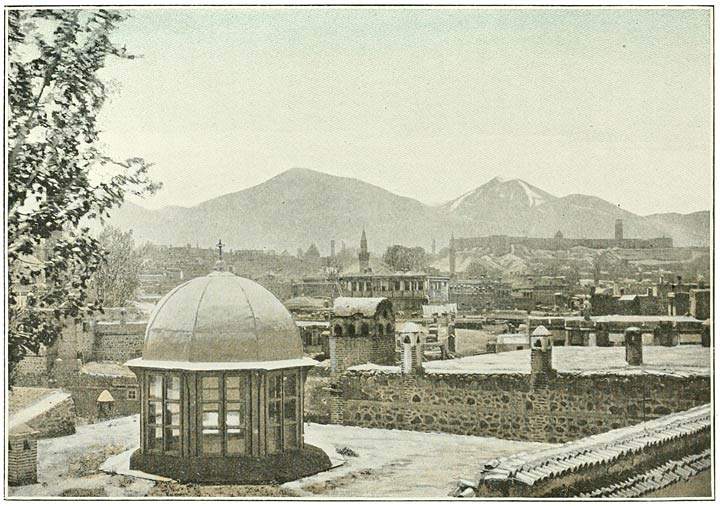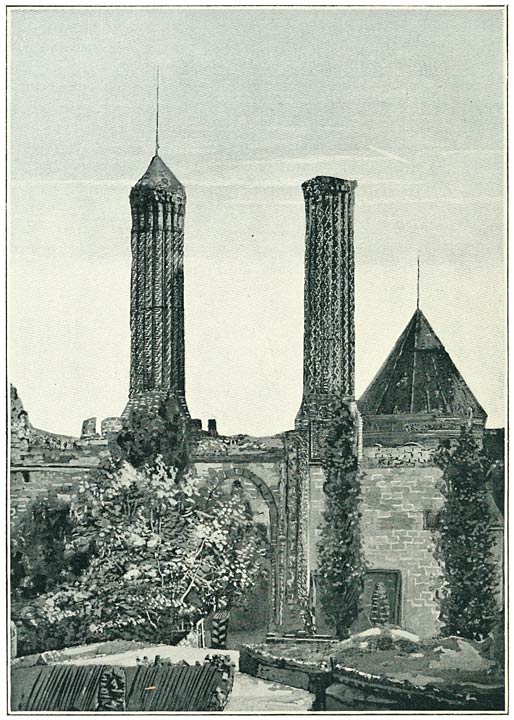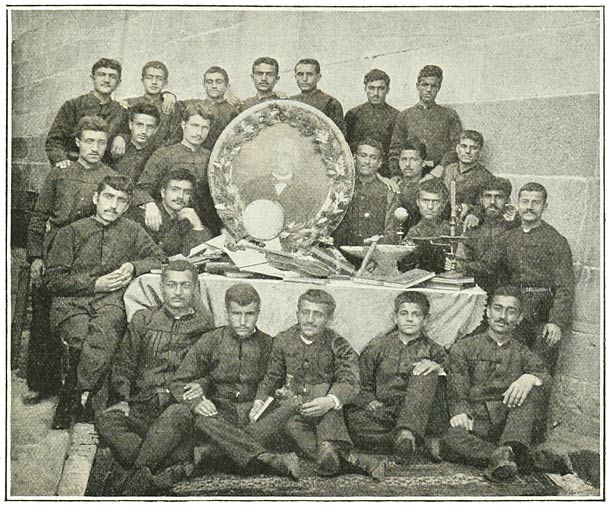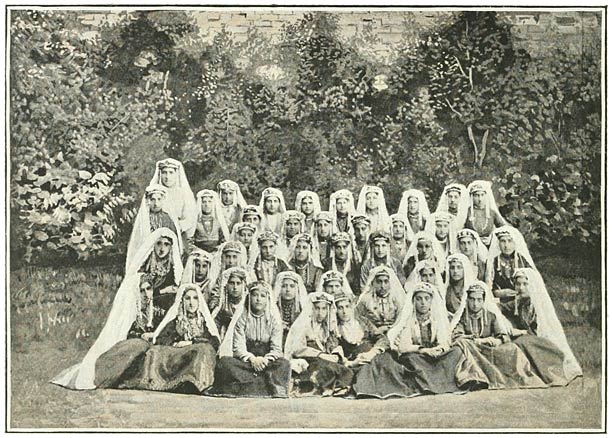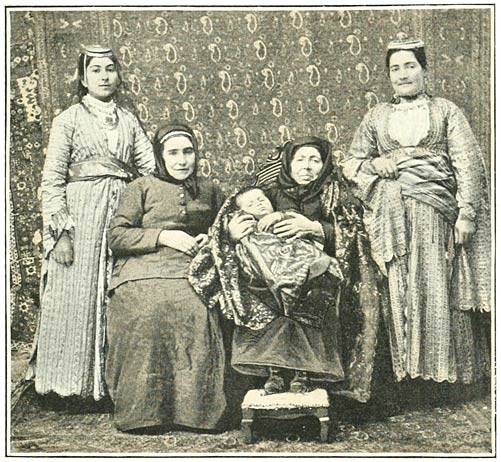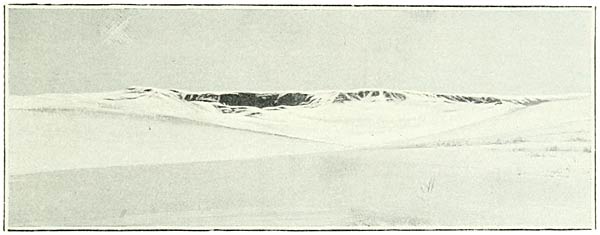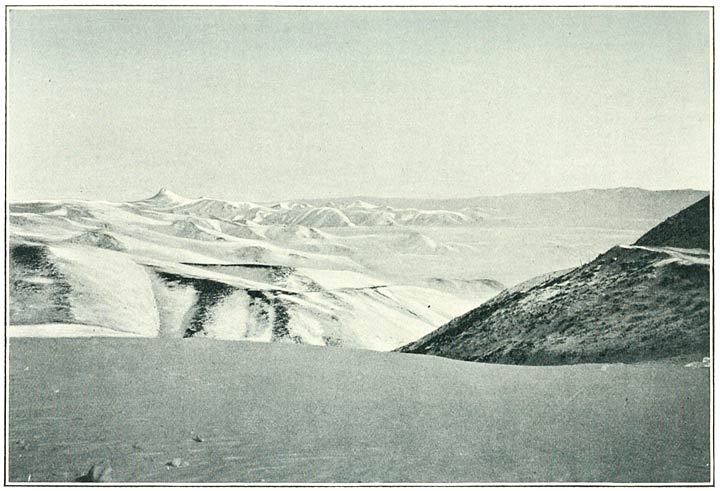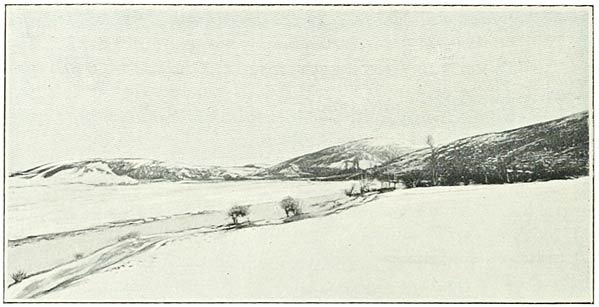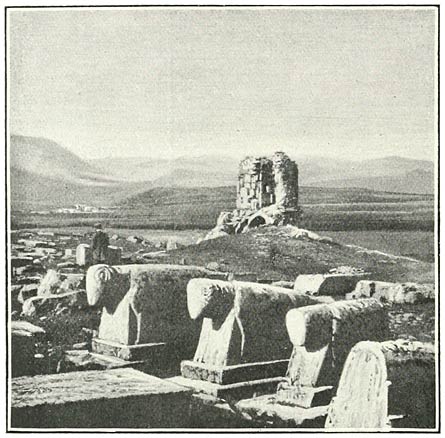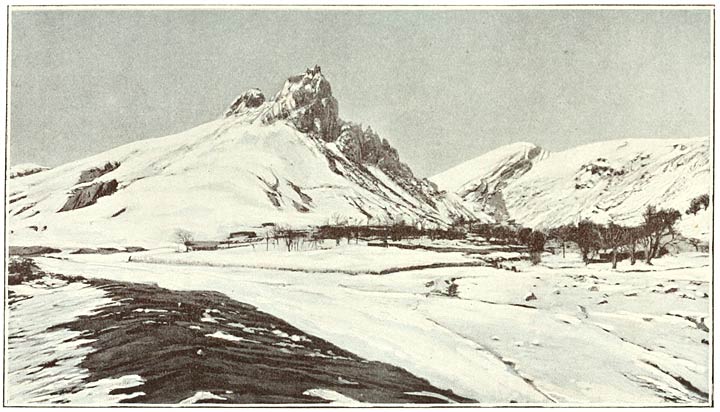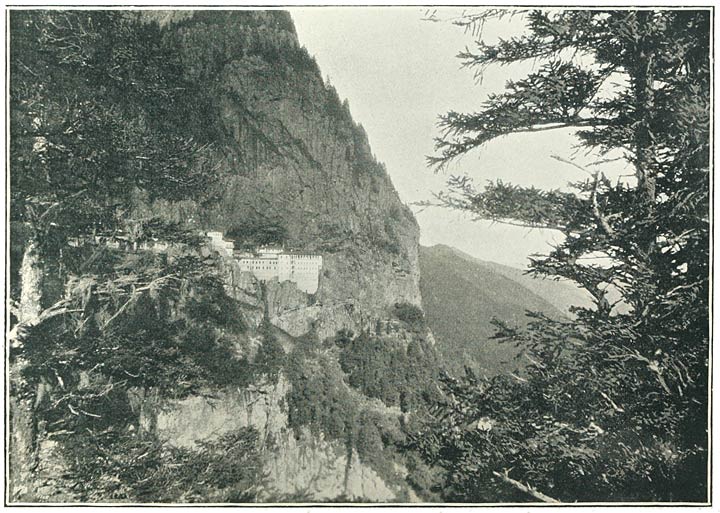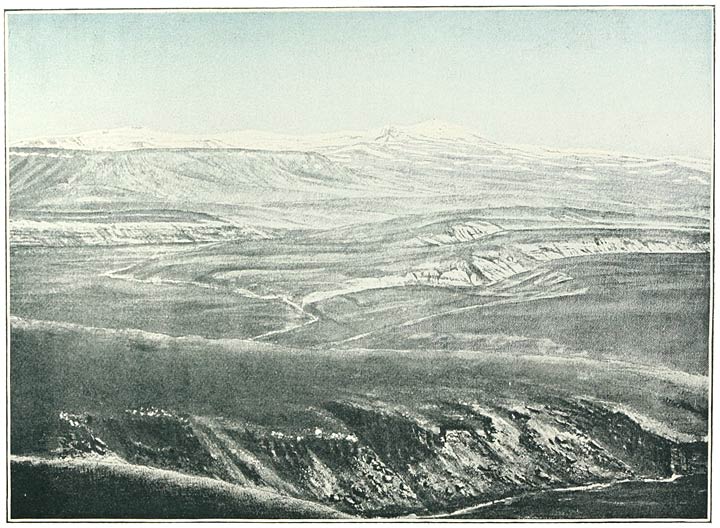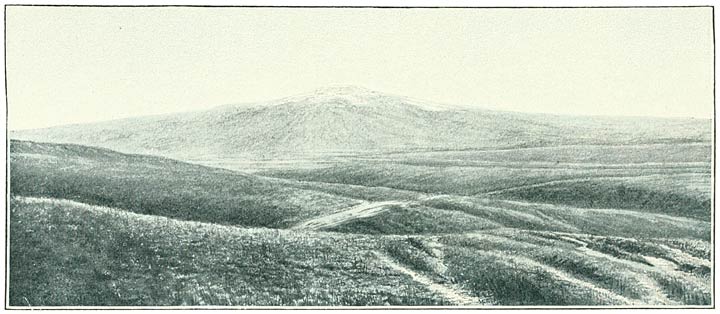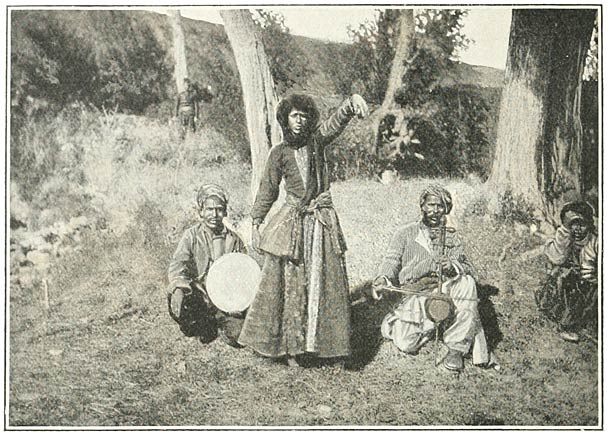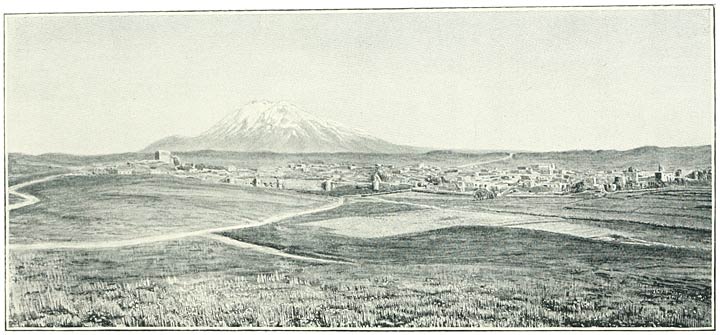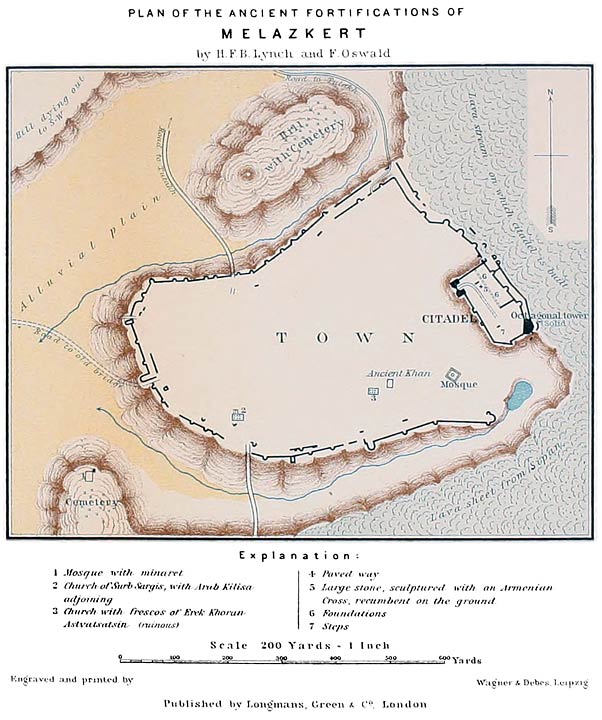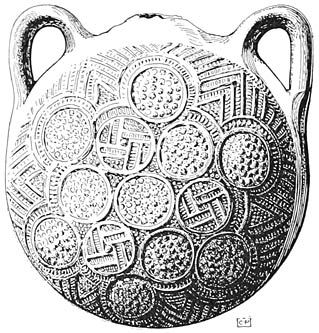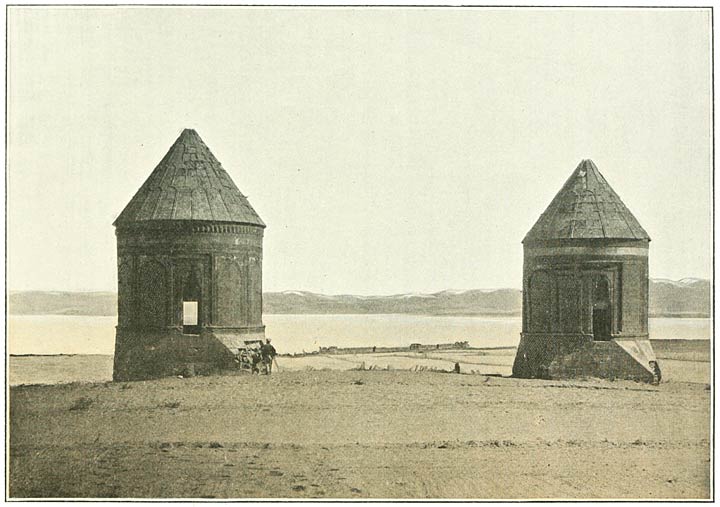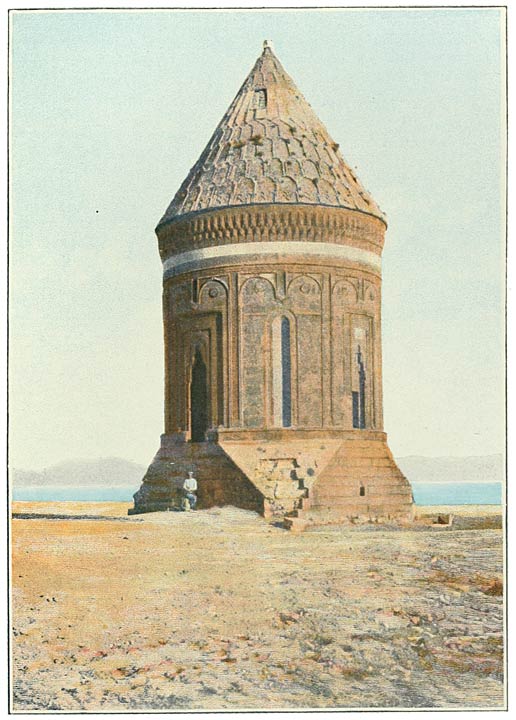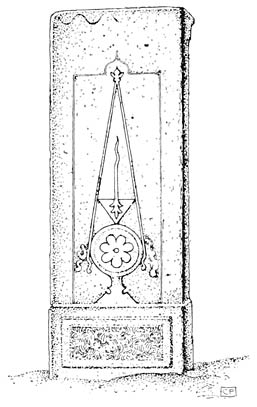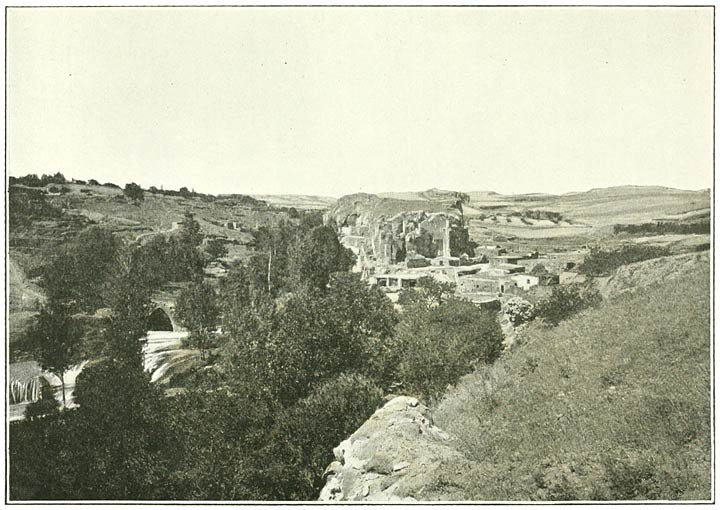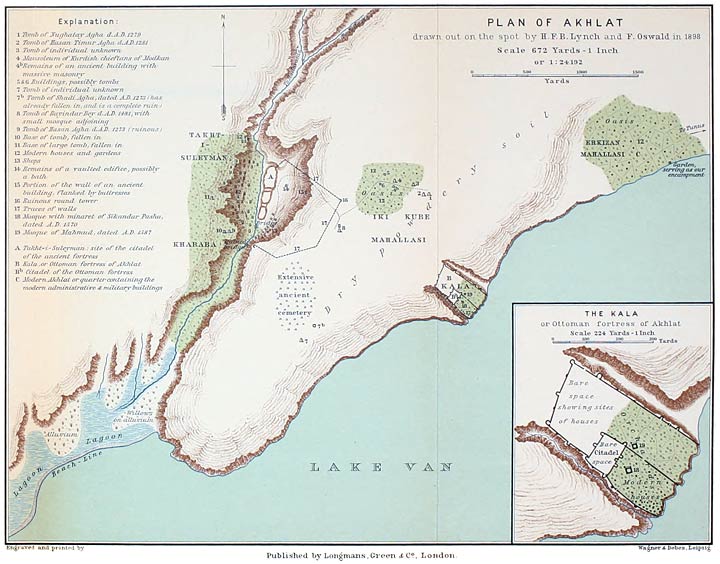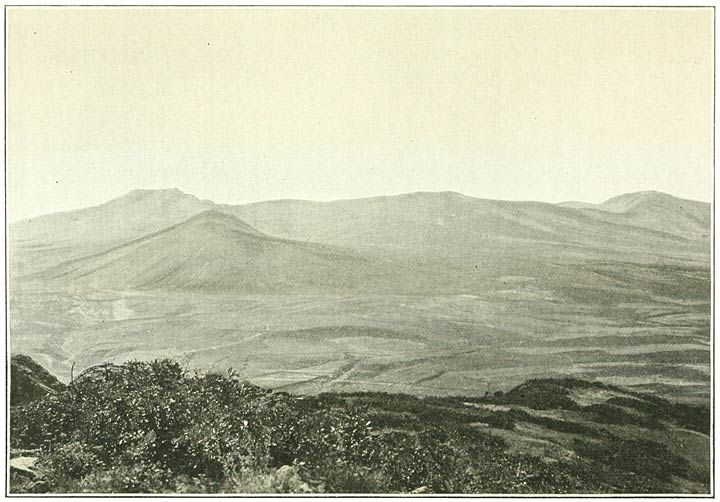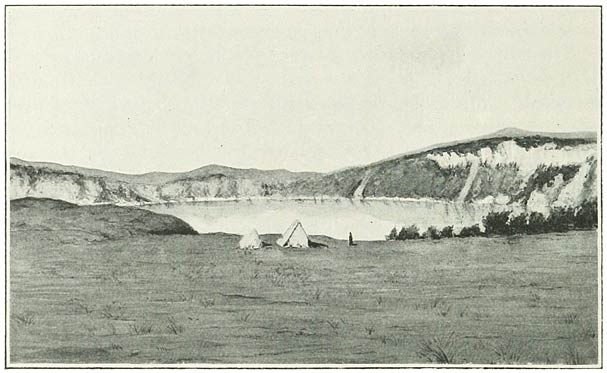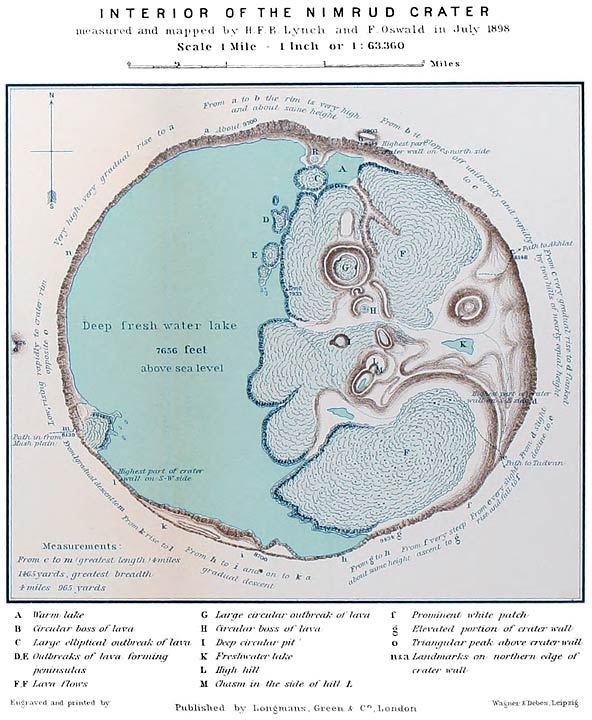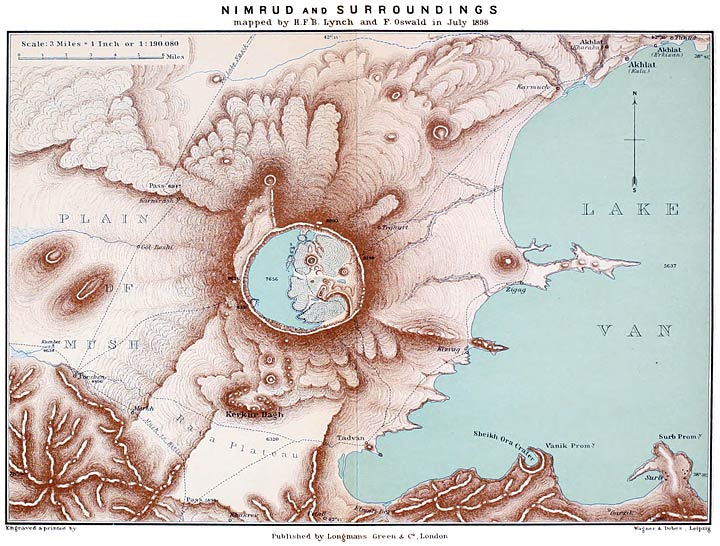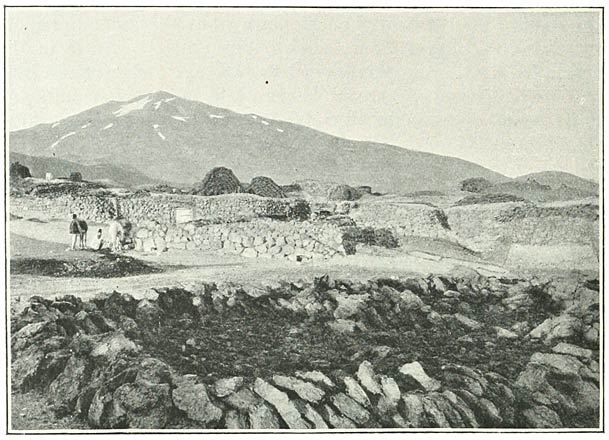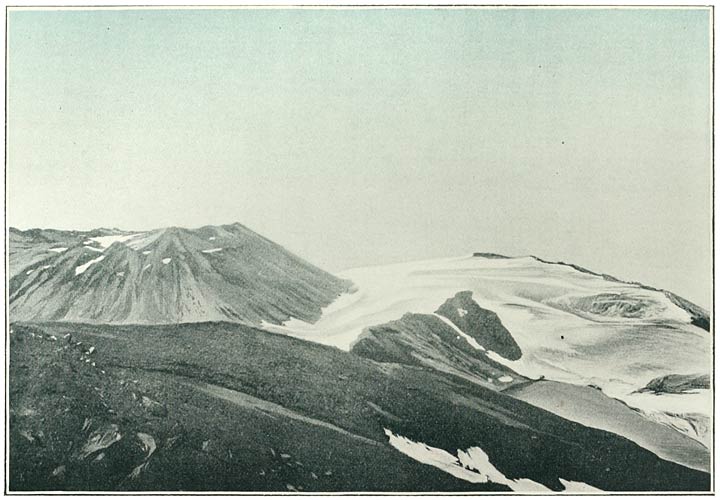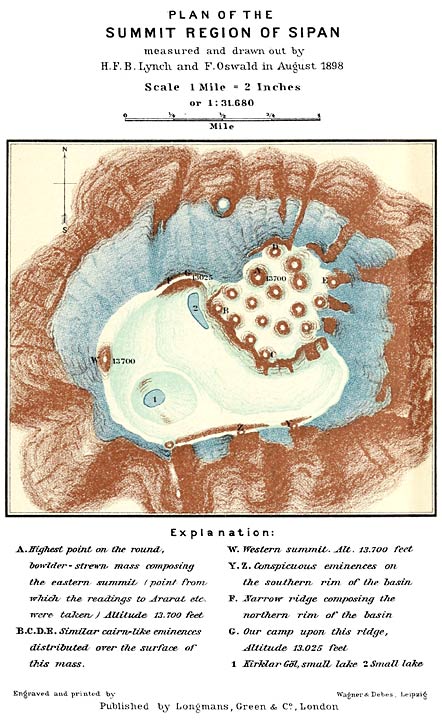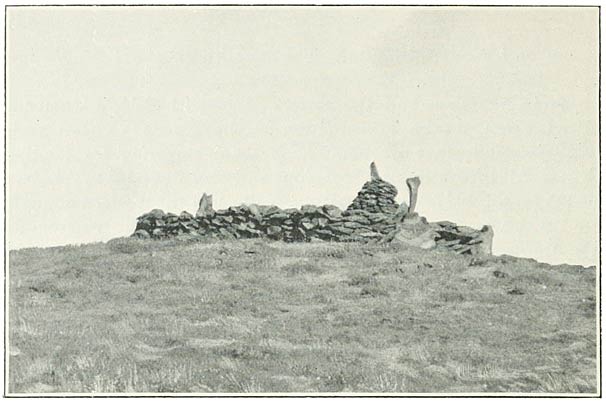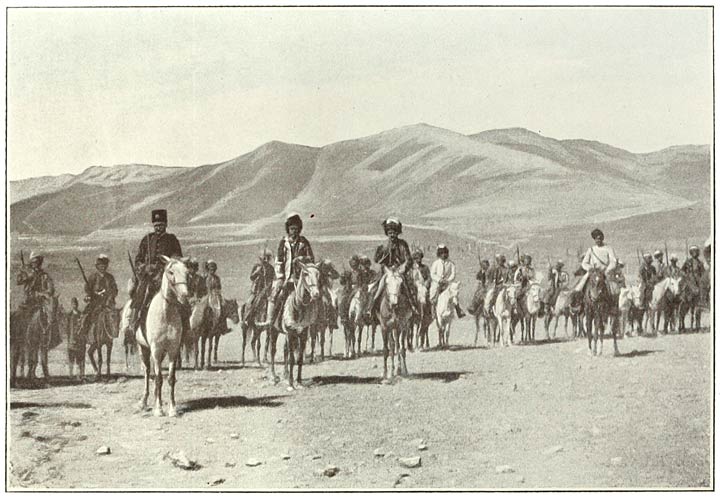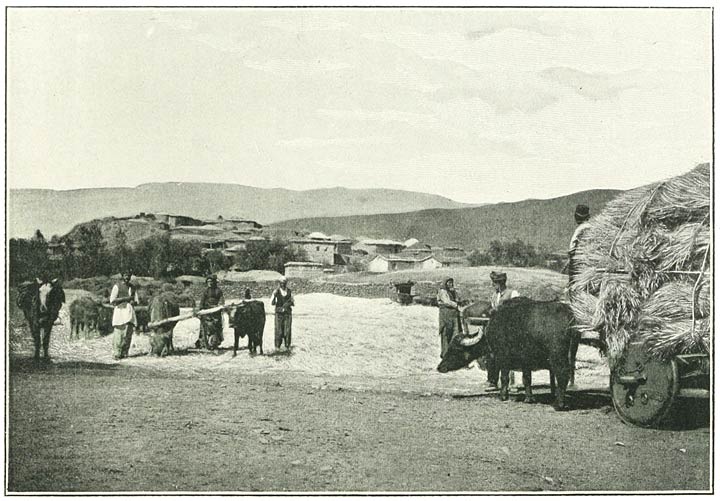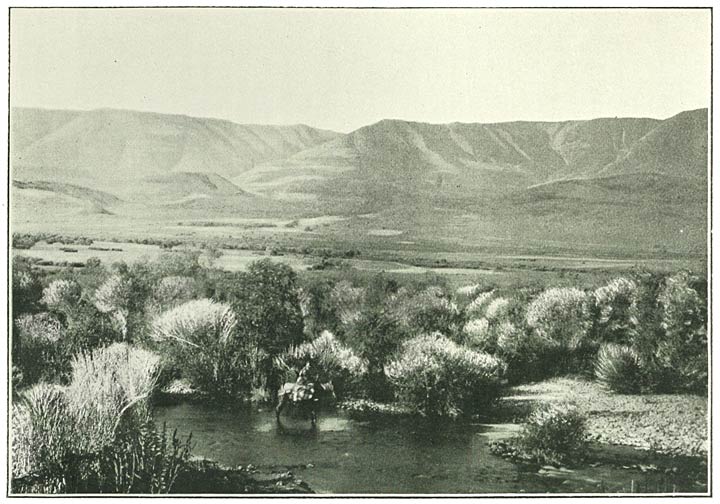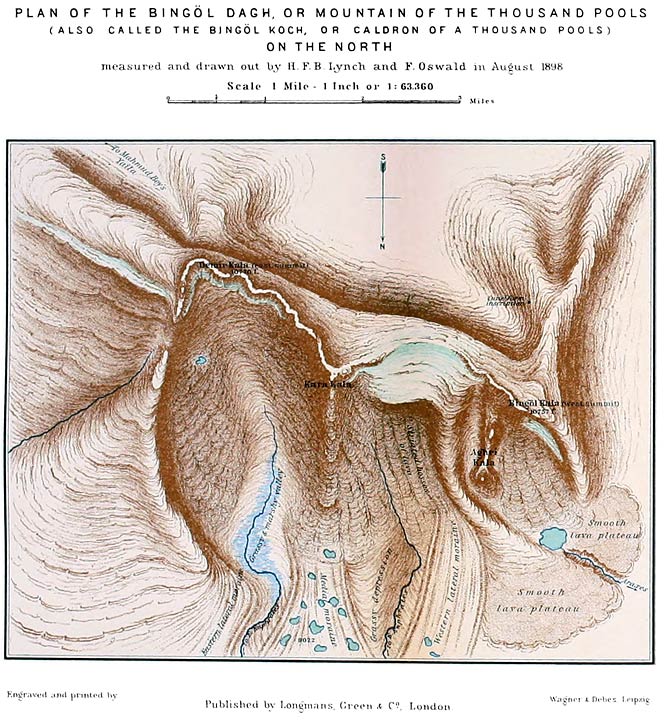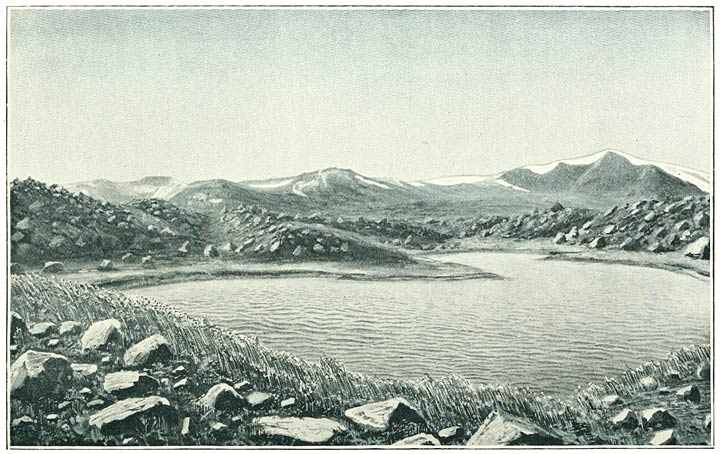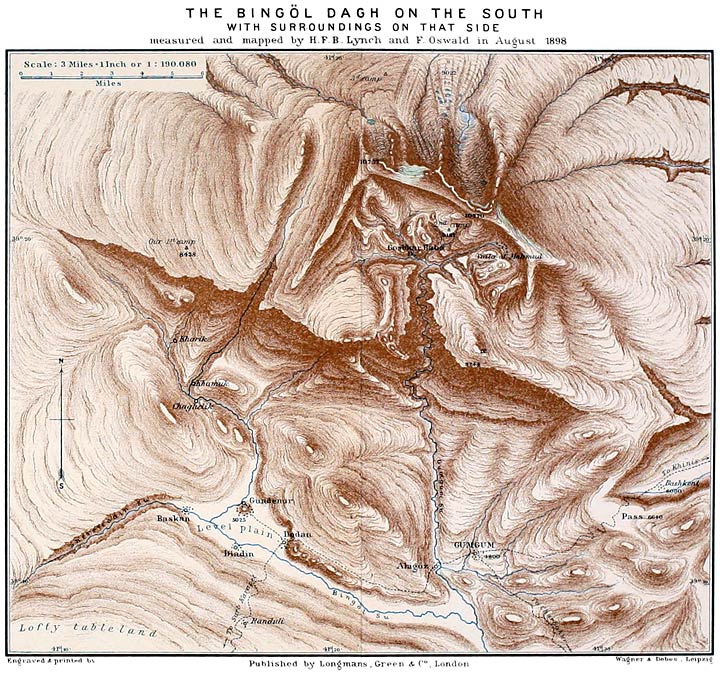Abagha Plain, ii. 401
Abaran (Kasagh) river, i. 136, 242, 316
Abas, king of the Bagratid dynasty, i. 352, 390, 407
Abastuman, Russian watering place, i. 48, 53–55,
432
Abazbek, posting station, i. 84
Abbas, Shah of Persia, transports a colony of Armenians
to Ispahan and carries off slabs from Edgmiatsin, i. 262, 264 note
5.
Comes into possession of Van, ii. 78.
Reputed to have taken Kars, i. 396
Abdul Miseh, grave of a supposed king of this name, ii.
133
Abdurrahman Gazi, valley and pass into Tekman from
Erzerum, ii. 202
Abgar, king of Edessa, who is said to have corresponded
with Christ, i. 278,
is claimed by the Armenians as one of their own royal line,
ibid.
Receives St. Thaddeus and with his people embraces the Christian faith,
ibid. and 277 note 2.
Under his successors his people lapse into polytheism, 278.
The authenticity of the story of Abgar is examined by Professor
Carrière, who shows that Moses of Khorene used an Armenian
version of this legend which began to form about A.D. 250, ibid. note 2
Abich, Hermann, i. 78, 79, 166, 177, 182, 187, 188,
191, 192, 193, 195, 199, 388, 394, 437, 445. ii. 376, 383, 386; i. 93,
174, 340, 374, 375, 381, 383, 385, 386, 416, 434, 435, 442, ii. 43, 46,
47, 76, 229, 363, 385, 401, notes
Abkhasia, i. 42;
its Bagratid king, i. 356
Abul, Mt., i. 92–95, 104, 105, 119, 441
Abul, village of, i. 92, 93
Abul-Samsar volcanic system, i. 95, 441
Abulsevar (Chawir, Aplesphares), chief of the
Beni-Cheddad family, q.v.; styled by Byzantine annalists and
Armenian writers prince of Dvin, i. 365; 362, 363, 365 note 1
Abulsevar, prince of Ani, i. 365
Abu-Said, Mongol king of Persia, his edict at Ani, i.
377
Achote, Monseigneur, Superior of the Monastery of Mugni,
i. 141
Adamanli, a division of the Hasananli Kurds, ii. 21,
26
Adeljivas (Lake Van), town of, ii. 326–330,
403.
Mileage to Akhlat, ii. 325 note.
Earthquake there, 47 note 1; 341.
Rise in the level of Lake Van there, 52.
Cuneiform inscriptions there, 75
Adrianople treaty of, i. 36, 125; 397. ii. 204.
Exodus of Armenian population from Erzerum province as a result of, ii.
206
Afrikean, M. Karapet, improvement in wine accomplished
by, i. 226
Afshin, Arab Governor of Azerbaijan, i. 341–343,
352
Agathangelus Treatise, our earliest authority for the
reign of Tiridates and the events connected with the conversion of the
Armenians as a nation to Christianity, i. 291 note.
Von Gutschmid has succeeded in discriminating between the various
sources from which the treatise has been built up, ibid., 295
note 1
Aghdznik, ancient Armenian province, ii. 429; i. 309
note 1
Aghri Dagh, name given by the Mussulman peoples to
Ararat as well as to the Ararat system, i. 148, 197, 409, 414 (Fig.
101), 415, 419 (Fig. 106), 420 (Fig. 107), 423, 435, 436. ii. 10
(Fig. 112), 384 seq.
Frontier between the Russian and Turkish empires, i. 435. ii. 384.
And see Shatin Dagh
Aghzi Achik, pass over the heights south of Erzerum, ii.
202
Agriculture finds in Armenia extremely favourable
conditions, due to the climate and the nature of the soil—a
mixture of lavas and lacustrine deposits, i. 87, 105, 442. ii. 255,
345, 404, 405–406.
Character of and seasons in various districts, i. 56, 57, 73, 75, 94,
105, 106;
among the Dukhobortsy, 107; 118, 121, 123;
on the plain of Alexandropol, 131; 133;
in the valley of the Araxes, 142, 202, 203, 229, 316, 318, 444; 321,
326, 410, 411; 443;
in Alashkert and basin of Upper Murad, ii. 3, 15, 19, 277;
in basin of Lake Van, 82, 315;
in plain of Mush, 167, 172, 318;
in plain of Khinis, 188, 256, 258;
in Bulanik, 344–345;
among the Circassians, 331, 353; 359;
in plain of Kharput, 391.
Backwardness in Russian Armenia, i. 56, 139,
and causes, i. 225, 461;
in Turkish Armenia, ii. 21, 164, 218, 219, 259,
and causes, ch. xxiv. passim.
Estimate of the levels at which cereals will flourish in Armenia, i.
107 note
Agrikar Dagh, peak of the Gori Mokri in Northern
Armenia, i. 87, 434
Ahmed, Arab Emir, cherishes pretensions to the district
of Taron (Mush), i. 343,
and defeats Sembat I., ibid.
Aiana, Greek Monastery of, ii. 238
Aiger Göl, on the southern slopes of Sipan, ii.
339
Ainalu Dagh, Kars district, i. 394
Ainsworth, Mr. W. F., ii. 162, 176 note
Aintab, Mesopotamia, massacre there, ii. 427
Ajara, Mts. and district of, i. 41, 42, 62, 437, 442
Ajars, The, i. 42, 432
Akantz, town on N.E. coast of Lake Van, ii. 26.
Pop., ibid.
Mileage from Karakilisa, 12
Akhalkalaki, town in Northern Armenia (Govt. of Tiflis),
visited and described, i. 86 seq., 66 note, 72, 85, 438,
455.
Pop., 86.
Brave defence of by the Turks against the Russians in 1828, 89;
schools in, see under Education
Akhalkalaki, plain of, i. 87 and note.
Character of the soil, 442
Akhalkalaki (Toporovan) river, i. 76, 78, 87, 88, 92
Akhaltsykh, town in Northern Armenia, visited and
described, i. 58–61 and 64–71.
History, i. 66–67;
was captured and partly razed by the Russians in 1828, 67;
the Mussulman pop. emigrated into Turkey and the town received large
bodies of Armenian immigrants, ibid.;
reasons given by inhabitants for the decline in prosperity, 68;
pop. [498]in 1833, 67;
in 1886 and 1891, 65 and note 2;
description of the modern town, 68;
of the old town, 69;
of the Jewish quarter, 70;
schools in, see under Education.
Mileage to Akhalkalaki, 72
Akhaltsykh river, i. 57, 73
Akhaltsykh-Imeritian Mts., i. 430, 431, 433, 434, 438,
441
Akhashen, valley of, i. 74
Akhashen, village of, i. 75
Akhavank (Iskele), residence on the mainland of the
Katholikos of Akhtamar, ii. 126
Akhbaba Dagh, peak of the northern border heights of
Erzerum, ii. 203, 227
Akhbaba Dagh, Lake Chaldir, i. 438
Akh Bulakh Dagh, peak of Aghri Dagh, i. 420
Akh Dagh (Tekman Dagh, Kozli Dagh), name applied to the
northern border heights of the plain of Khinis, ii. 189.
View of from the south, 186 (Fig. 159);
from the Palandöken Pass, 249;
from village of Demian, 277;
from summit of Khamur, 351;
from Bingöl Dagh, 372.
Appearance of from Tekman, 249,
from the plain of Khinis, 256–258,
from the Kartevin Dagh, 269.
Structure and composition of, 389, 402
Akh Dagh, Akhmangan region, i. 445
Akh Deve (White Camel Hill), Kars-Kagyzman district, i.
412
Akher Göl Su (plain of Khinis), source of the, ii.
257
Akhja Kala, Tartar village on southern slopes of
Alagöz, i. 320
Akhlat, is the name of a district on the north-western
shore of Lake Van, which includes:
1st, the ancient city of Akhlat, now known as Kharaba or
Takht-i-Suleyman, situated in a ravine some distance from the shore;
2nd, the Ottoman fortress of Akhlat (Kala) on the shore; 3rd, the
modern township in the quarter of Erkizan, ii. 284.
Pop. of entire district, ibid.
Characteristics of the site, ibid.
Erkizan described, 285;
the Kala described, 287–289;
the ancient city described, 291–292.
The mausolea or kumbets described and their dates ascertained,
285–293.
The ancient cemetery, 290.
History of Akhlat, 294–297; i. 355, 360, 366.
Mileage to Adeljivas, ii. 325 note.
Plan, ii. 296
Akhtamar, Lake Van, island and monastery of, described,
ii. 129–135;
architecture of the church, 132, and date, 131
Akhtamar, Katholikos of, his jurisdiction and status,
ii. 135, and cp. i. 276;
visited at Akhavank, ii. 127–129, 135–136
Akhurean river, see Arpa Chai
Akhury (Arguri, Acorhi, Akuri, Agguri, Arkuri), ancient
Armenian settlement on Ararat, destroyed by the catastrophe of 1840, i.
183 seq.;
is said by the Armenians to have been built on the site of Noah’s
vineyard, 183;
their attempt to connect it with the Armenian for “he has planted
the vine” has probably led to a corruption of the name,
ibid. note 4.
May it not be the Adduri of the Assyrian inscription of Shalmaneser
II.? ibid.
A willow tree there was said to have sprung from a plank of the Ark,
183,
and the church to have been built on the site of Noah’s altar,
erected on his departure from the Ark, ibid.
The date of the church, 184.
Pop. according to Dubois and Wagner, 183, 184 note 1.
There was also at A. a square fortress built of clay, 184;
and a summer palace for the Persian Sirdars of Erivan, ibid.
Account of the catastrophe of 1840, 185–187;
investigations undertaken by the Russian Govt., 187.
Divergent conclusions of Wagner and Abich as to character of
convulsion, 188.
What remains of the ancient settlement at the present time, 192,
193.
The old cemetery with the graves of seven brothers said to have been
killed by a single snake, 193
Akhury, chasm of, Ararat. Entrance to the chasm, i.
184;
Kurdish village at the mouth of the chasm, 192;
excursion up the ravine, 193;
the peculiar formation of a side valley, ibid.;
which probably owes its distinctive features to the action of ice,
194;
arrival at St. Jacob’s Well and the sacred rose bush,
ibid.,
elevation of the site, 195.
The boulders covering the bottom of the ravine are worn by the action
of ice and water, 195.
According to Abich the long ridges which appear in his illustration
were composed of dirty glacier ice, covered with stone and
débris, 195;
but we did not see any ice in the trough of the chasm, 196,
though we admired a lake of glacier water, ibid.
Akhury, New, settlement of Tartars on Ararat, i.
193;
pop., ibid.
Akhviran Pass into the Khinis Plain, ii. 249, 252,
373
Akhviran, village of, ii. 278
Ak Köpri, crag of near Van, ii. 111, 112 note 1
Ak Köpri, river, ii. 112
Ak-kul (Gubudgokh) Mt., west of Akhtamar, ii. 137
Akrag, Armenian village on the Murad near Shakhberat,
ii. 351
Akstafa river, tributary to the Kur, ii. 39, 40, 437
Akstafa station, i. 39, 226
Ala Dagh Mts. (Nepat, Niphates), ii. 10, 12, 22,
401.
Seen from Lake Van, 31, 121;
from Kartevin Dagh, 269.
Strabo says that the Tigris rises in these mountains, ii. 41.
Viewed from Tutakh, 265.
A seat of the Thonraki (Thonraketzi), i. 285
Ala Dagh, Chaldiran district, i. 413 note
Ala Göl, i. 434
Alagöz, extinct volcano and natural barrier between
Northern Armenia and the valley of the Araxes about Erivan, i. 119,
124, 147, 438, 444; 135, 148, 149, 152, 205, 228, 325, 326, 330, 331,
367, 419, 442.
Seen from summit of Abul, i. 95;
from plain of Alexandropol, 122 (Fig. 23), 127, 134;
from the east, 136 (Fig. 28);
from Erivan, 208 (Fig. 41);
from Ararat, 138;
from the plains on the west, 327 (Fig. 68).
Journey along the southern slopes, i. 316 seq.
Alagöz, hamlet of near Gumgum, ii. 358
Alaja (Tsaghkotz) river at Ani, i. 368, 369
Alaja Dagh, i. 330, 368, 399
Ala-Kilisa, village of Armenian-speaking Greeks, i.
122
Alander, Col., Governor of Akhaltsykh, i. 60, 61, 64,
65, 66
Alarodians, name by which the inhabitants of Urardhu
were known to Herodotus, ii. 67 and note 4;
were joined with the Matienians, etc., in 18th satrapy of the Persian
empire, 68
Alashkert, plain of, i. 148, ii. 2 seq. and
Fig. 108, 384, 389, 400, 401, 404.
Elevation of, ii. 3
Alexander I., Emperor of Russia, extends great
privileges to the Protestant emigrants from Würtemberg on their
arrival in Georgia, i. 97.
Encourages Protestant missionary enterprise, 99.
His humane and liberal policy towards the Dukhobortsy, 103
Alexander Severus, Roman Emperor, i. 287
Alexandropol (Gümri), Russian fortress town on the
Arpa Chai visited and described, i. 124–132, 330, 443, 445, 453,
455, 462, 467. ii. 46 note.
Visited by Emperor Nicholas I. in 1836, i. 125.
History and description of city, 124–125, 127–129;
pop., 124 and note 1;
is almost exclusively inhabited by Armenians, 124;
who have inherited the love of building of their forefathers, 127;
but their churches and other buildings are pretentious and commonplace,
128.
Greek chapel of St. George with Byzantine picture of St. George and the
Dragon, 129.
Schools in, see under Education
Alexandropol, plain of, i. 122, 131, 133, 134, 442. ii.
404
Ali Bey, chief of Karapapakhs at Karakilisa (Alashkert),
ii. 6, 255
Ali Bey, chief of Sipkanli Kurds, ii. 267, 268
Ali Gedik, village near Charbahur on the Murad, ii.
352
Ali-Kuchak, village on Alagöz, i. 137 [499]
Ali Mur, hamlet of Kizilbash Kurds, district of Shushar,
ii. 252
Alkhes, village of the district of Elmali Dere, ii. 262,
263, 399
Allah Akbar Dagh, Soghanlu range, i. 441
Allen, Mr., American missionary at Van, ii. 92
Allen, T. G., and Sachtleben, W. L. Their ascent of
Ararat, i. 199
Alp Arslan, Seljuk sultan, captures Tiflis, i. 337,
and Ani, 353, 363,
and Melazkert, ii. 275
Altai Mts., their connection with the structural system
of Asia, i. 424, 425
Altun, plain of, Upper Araxes, ii. 379, 398
Alur, village, Van district, ii. 122
Amasia, Turkish settlement on the Arpa Chai, i. 122
Amat, Armenian village, district of Alashkert, ii. 2
American Missions, see Missions
Amisus, ruins of (near Samsun), i. 4
Anak, Parthian of the blood royal, murderer of the
Parthian King of Armenia, Chosroes, and father of St. Gregory, i.
288.
View of Von Gutschmid, ibid. note 2
Anania of Shirak, i. 312, note 1
Anastasius, Roman Emperor, ii. 222
Anguil Su (Enghil Su) or Khoshab, river flowing into
Lake Van, ii. 122
Anguil, village, ii. 123
Ani, Armenian mediæval town and fortress on the
Arpa Chai (Akhurean), now in ruins and uninhabited, visited and
described, i. 329, 334, 354–392, 268, 269;
history of, 354–366; 345, 350.
Description of the various buildings and fortifications,
369–390;
distinctive features of the architecture of the Ani buildings, 390;
appeal to the Russian Government for their preservation, 391;
date of the Cathedral, 354, 355.
Mr. Marr’s excavations at Ani, 377–378.
Plan, 309
Ani, the modern Kemakh, ancient Armenian fortress on the
W. Euphrates, i. 294;
fane of Aramazd at this place destroyed by St. Gregory and King
Tiridates, ibid.
Anti-Taurus Mts., their connection with the structural
system of Asia, i. 424;
probable representatives of the A-T. elevation in Armenia, ii. 386
Aplesphares, see Abulsevar
Aplgharib, Pahlavuni family at Ani, i. 382, 383
Apughamir, Pahlavuni family, son of Vahram, i. 382, 383
note 3, 385
Arabion Castellum on the Gt. Zab, i. 277 note 2, 279
Arabkir, massacre at, ii. 412
Arakelotz Vank, plain of Mush, ii. 166
Arakh Su, Mush plain, ii. 166
Aralykh, Russian military post at the foot of Ararat, i.
154–155;
climate of, 202
Aramzalu, village of, district of Erivan, i. 154
Ararat, Mt. (Masis of the Armenians, Aghri Dagh of the
Tartars), first view of from the southern slopes of Alagöz, i.
137.
It does not appear that there was an independent local tradition of the
Flood, 197;
but the identification of Ararat with the mountain upon which the Ark
rested may have been made by Jewish prisoners of war, ibid.
The Ararat of Scripture is the Assyrian Urardhu, ibid. and ii.
57—a geographical designation which appears to have travelled
north during the course of time; the historical Urardhu or Ararat is
the province around Mt. Ararat, well known as Ararat to Agathangelus
and other early Armenian writers, i. 197.
Supposed vestiges of the Flood, 157.
The district has been covered within comparatively recent geological
times by a lake, 317, ii. 404
The fabric of Ararat is built up by Great and Little Ararat, i.
197;
though due to eruptive volcanic action, no eruption is known to have
occurred during historical period, 197, 188.
View of from the plains about Erivan, 149, 198.
Orography, 148–153, 156, 197.
Vegetation abundant on parts of the mountain, 160;
also partridges, ibid.;
but the fabric is entirely devoid of trees, the only wood being a
covert of low birch, 161.
Ascent of, 167–178;
start made from the encampment at Sardar Bulakh, 167.
Three structural divisions to be distinguished in that part of the
mountain between Aralykh and the summit, 170.
The great snowfield has a minimum depth of 2000 feet, 171.
The south-eastern summit attained, 176.
Temperature of the air a few feet below the summit, 177 note.
Descent to encampment of Sardar Bulakh, 179.
Best season and starting point for the ascent, 37, 199.
List of successful ascents, ibid.
View of Ararat from the summit of Sipan, ii. 336, 337
Ararat, Chasm of Akhury, see under Akhury
Ararat, Monastery of St. Jacob, i. 184
Ararat, Little, i. 149, 150, 160–168 and Fig. 33,
197, 199, 436
Araxes river (Aras, Egri Chai), sources of on the
Bingöl Dagh, ii. 374 and Fig. 194;
its course through Armenia, ii. 379, 251, 190, 192 seq., i. 138,
146, 154, 201, 317 seq., 416, 436, 444, ii. 406, and see
Bingöl Su
Araxes, plain of the (district of Ararat), i. 130, 137,
138, 146, 154, 201, 206, 317 seq. 444.
Elevation, 146.
Tradition that it was the seat of Paradise, 318
Archelaus, Bishop of Karkhar, author of a disputation
with Mani, was probably bishop of a see not far from Van, i. 279 and
note 3.
Adoptionist theory, 281
Ardabil, town in Persia, i. 366, 387, 435 note
Ardahan, town and district in Northern Armenia, i. 443;
66 note 1, 430, 431, 432, 437, 438, 439
Ardahan river, see Kur
Ardasa, town of, ii. 243
Ardashir, first Sasanian King of Persia, i. 286;
the supporter of the fire-worshippers, 287;
is harassed by Chosroes, Arsakid King of Armenia, 288,
whose death he encompasses, ibid.
Ardavan, Arsakid King of Persia, i. 286
Ardos, Mt., Lake Van, ii. 123, 126, 135, 137, 279
Arenjik, Kurdish village on the slope of Kolibaba, ii.
348
Arghana, town in Mesopotamia, ii. 388, 396
Argistis I., Vannic King, ii. 61, 73
Argistis II., Vannic King, ii. 75.
Inscription of, at Hargin, ii. 29
Arjish, ruins of (Lake Van) some miles south-west of
Akantz, ii. 26 seq.
The site to be distinguished from an earlier Arjish, 27 seq. and
71.
Deserted by its inhabitants owing to rise in level of the lake, 30.
Was known to Marco Polo as one of the greatest cities of Armenia,
29
Armavir, ruins of, i. 318, 319, ii. 61, 71, 73–74,
76
Armenak, son or grandson of Hayk, progenitor of the
Armenians, i. 318
Armenia, natural boundaries of, i. 428–35, ii. 231
note 1, 235–236, 244, 386–390, 394.
Its connection with the system of the great Asiatic tablelands, i.
421–428.
Geology of, i. 428, ii. 402–404, and passim in the
narrative of the journeys.
Characteristics of, i. 52, 86, 428, 429, 436–439, 449, ii.
235–236, 244, 382, 400, 405–407.
It is naturally divided into two parts by the Ararat system—a
north-easterly and a south-westerly, i. 409, 435–436, ii.
384.
Limits and characteristics of north-easterly or Russian Armenia, i.
436–445;
area, 445;
Pop. 451.
Do. of south-westerly or Turkish or Tauric Armenia, ii. 386–394,
397–406;
area, 407;
pop.,
412–414.
Communications with Armenia, i. 7, 39, 431, 432, 433 note, 437, ii. 89,
148, 203, 205, 225, 239, 240 note, 382, 388, 390, 396.
Routes and communications in Armenia passim in the narrative of
the journeys and i. 146, ii. 393
Armenia, history of, seems to fall naturally into four
periods,
(I.) the pre-Armenian period, with an obscure interval preceding the
rise of the Arsakid dynasty, i. 285–286, ii. 70 and
53–76;
(II.) the Arsakid period, with an interval preceding the evolution of
the petty Armenian dynasties of the Middle Ages, i. 286–312;
(III.) the Armenian Kingdom of the Middle Ages, i. 335–364, 391,
and
(IV.) a long sleep, dating from the overthrow of [500]that
kingdom by hordes of Seljuk Turks towards the close of the 11th century
to the advent of the modern epoch, i. 364–367.
Impressive part played in the history of these countries by the Roman
Empire of the East, i. 34.
Scanty knowledge of Armenia displayed by Greek and Roman writers, ii.
40
Local Mussulman dynasties have flourished in most of the great Armenian
centres, notably Akhlat, q.v. and i. 366.
Mussulman art is well represented by the ruins of the Ulu Jami at Van,
ii. 106, and by the mausolea at Akhlat, q.v.
Modern history of, i. 446, 458; 66, 67, 89, 96 seq., 124, 125,
210, 232 seq., 393, 396–399; ii. 78, 148, 149, 204, 205,
223, and see Armenian Movement
Armenian alphabet, i. 312 note
Armenian Church, history of, i. 276–314, and
cp. 264.
Ripsimian legend, 256–261.
Differences with the Greek and with the Roman Churches, 313–314
and note 1, 352, 363.
Contemporary importance of the A.C., 231
Hierarchy and Government of the Church:
The katholikos at Edgmiatsin the supreme head, i. 231, 276 (and see
298–300).
Elective character of his office, 231, 233 note 2.
The synod at Edgmiatsin, its antiquity and functions, 234, 235, 218,
220;
revived by the Russian Govt. and provided with a Russian procurator,
234.
The Tsar appoints its members, 235.
Fetters placed upon the katholikos by the Russian Govt., 235.
The Regulating Statute or Polojenye, 233–236.
The twelve bishops at Edgmiatsin, 253.
The bishops, monks (vardapets) and parish priests, 274, 275, and
233 note 2.
The A.C. represents a compromise between opposite principles in the
organisation of Christianity, 276 and 307.
Power of the laity, 276; ii. 213.
The patriarch of Constantinople, ii. Appendix I.;
his relations to the katholikos, i. 276.
Regulation of the Armenian Church in Turkey, ii. Appendix I.
Need of reforms in the A.C., i. 469, ii. 93.
Reforming spirit of the present régime at Edgmiatsin, i. 274
Armenian architecture, i. 63, 131, 262–272, 323,
369–390, 407, ii. 34, 101–102 (the log churches of Van),
106, 107, 114, 115, 131–133, 155, 179, 188, 233, 271.
Love of building among the Armenians at all periods, i. 127, 265,
344.
Their architecture exhibits capacities of the first order, i. 391.
Characteristics of the style, i. 390.
The conical dome, i. 63.
Function of the niche, i. 269.
Possible traces of Assyrian influences, ii. 65, 132.
Their churches exhibit the coupled pier, wand-like pillar and pointed
arch at least as early as the commencement of the 11th century, i.
372.
Influence upon them of Mussulman art, i. 391;
their influence upon Mussulman art, ii. 294.
Instance of conveying stone from a great distance, ii. 131 note 2
Armenian language, its harshness to the ear, i. 450, ii.
33, 236
Armenian music, i. 250, 254, 255
Armenian Movement, i. 239–242; ii. 83–87,
157–159, 408, 420–423, 428–429, 432.
The talk about a modern Armenian Kingdom examined, i. 468, ii. 435
Armenian Constitution (in Turkey), ii. 436, and Appendix
I.
Armenian law, i. 367
Armenians, The, their capacities and character, i. 255,
314, 391, 465–468.
Fidelity of Armenian women under trying circumstances, ii. 92.
The assistance the A.’s have rendered to the Russian advance, i.
233.
Their disillusionment, ibid.
Will they ultimately enter the Russian Orthodox Church? i. 463.
Their position in Turkey, see under Armenian Movement references
to vol. ii.
Ethnology of the Armenians, ii. 67, 390.
They have probably received at various epochs an admixture of Semitic
blood, ii. 70, i. 237, 299, 305, ii. 77, 99
Armutli, village near the Araxes, i. 440, 443
Aron-Magistros, General of the Empress Zoe, i. 373
Arpa Chai (Akhurean), i. 119, 121, 442; 122, 131, 327,
328, 363, 367, 368, 376, 377, 381, 386, 389, 453;
confluence with the Araxes, 319
Arpa Göl, i. 439
Arshak, King of the Arsakid dynasty, i. 304, 305, 307,
309
Arshakavan, a city of refuge founded by Arshak, i.
308
Arsissa, Areesa, name by which Lake Van was known to
Ptolemy, ii. 27, 42.
See also Van, Lake
Artaxata, ancient Armenian city in the district of
Ararat, i. 201; 258, 259, 271, 287 note 3, 288, 293, 294, 304, 305
Artemid (Atramit, Artamit), a village on Lake Van, ii.
119–121; 36, 42, 135.
Researches at made by Schulz, ii. 120 note 1
Arter, Islet of, Lake Van, ii. 135
Artsruni, The, ancient Armenian family of princely rank
claiming descent from a king of Assyria, i. 336, ii. 429.
Their vast possessions in Vaspurakan (Van) during the decline of the
caliphate, i. 336.
Their territory overrun and their prince captured by the Arab armies,
338.
Their attitude towards the Bagratuni family, raised to royal rank under
Ashot, i. 342, 343, 345, 346.
Their prince, Gagik, obtains a royal crown from the Arab governor of
Azerbaijan, 345, and allies himself with the Mussulmans against the
Bagratids, 346.
But the alliance is broken, 348, and better relations with the
Bagratids ensue, 349.
Gagik is crowned by order of the caliph, ibid.
Divergence of policy towards him on the part of the governor of
Azerbaijan and of the caliph, 349.
His territories overrun by the former, 350.
Visited by John Katholikos, ibid.
The Artsruni furnish one of the three kinglets of Armenia under Ashot
III., 354.
Their country experiences the first shocks of the Seljuk invasions,
356, 357, 359, and their king, Senekerim, bargains away his kingdom to
the Byzantine emperor, Basil II., in return for a retreat in the Greek
Empire, 357.
Extent of the ceded dominions, ibid.
Significance of the event, 359, ii. 77–78
Artsruni, Thomas, historian, i. 340 note 1; ii. 131 note
2
Artsruni, ——, his ascent of Little
Ararat, i. 199
Artvin, town and valley of, i. 430, 443
Artze (Artsn, Arzen, Erzen), unfortified town in the
vicinity of Erzerum, ii. 223;
may have been called Artze of Rum to distinguish it from an Artze in
Southern Kurdistan, ibid. note 6.
Sacked by the Seljuks in 1049, i. 358
Arzanene (Arrhene), a country comprised in the present
vilayet of Diarbekr, ii. 41
Arzasku, site unknown, capital of Arame, king of
Urardhu, ii. 59
Arzen, see Artze
Arzian Dagh, Northern Armenia, i. 441
Asbeleff, M., i. 54
Ashakh Dagh, Ararat system, ii. 384
Ashkala, Mohammedan village on the banks of the
Euphrates, ii. 226, 228
Ashkala Plain, special features of, ii.
228–229
Ashkhen, queen of Armenia, i. 261
Ashot I., king of the Bagratid dynasty, i. 339
seq.
Ashot II., king of the Bagratid dynasty, i. 347
seq.
Ashot III., king of the Bagratid dynasty, i. 353
seq.;
his tomb at Khosha Vank, 389, 390
Ashot IV., king of the Bagratid dynasty, i. 355
seq.
Ashtarak, a township near Erivan, i. 139, 140, 141,
142
Asia, structural features of, i. ch. xxi. and map
Asoghik, Armenian historian, i. 382, 390
Aspinja, Mohammedan village on the Upper Kur, i. 74,
75;
discontent of the inhabitants, ibid.; 66 note 1
Astishat (District of Mush), place famous for its
temples in pagan times, i. 295.
The temples destroyed by St. Gregory, ibid., who erects the
[501]first Christian church in Armenia upon the site,
296.
Site of Astishat identified with that of the present cloister of Surb
Karapet, 296 note 2
Astrakhan, diocese of the Armenian Church, i. 233 note
2;
emigration of Armenians to, 367
Astvatsadur, katholikos, i. 262, 264 note 5, 268
Atabegs, governors of Upper Georgia, i. 62;
they became independent kings of Georgia, and were suppressed at a late
date by the Ottoman Turks, ibid.
Atanon village, near Lake Van, ii. 123
Aternerseh, Bagratid prince of Georgia, i. 341, 343,
344, 345
Athenogenes, Christian Saint, whose bones were obtained
as holy relics by St. Gregory, i. 295 and note 3
Athenogenes, son of Yusik and father of Nerses the
Great, i. 303, 306
Aurelian, Roman Emperor, i. 281, 289 note 2
Avdi, village between Karakilisa and Tutakh, ii. 13
Avrin Dagh, Persian frontier, ii. 386
Ayubids, dynasty of Kurdish extraction in Mesopotamia,
descendants of Saladin, ii. 211, 295
Azat, village in district of Kars, i. 409
Azerbaijan, frontier province of Persia on the side of
Armenia.
Nature of the frontier, i. 428, 440.
Geology of, ii. 389.
Governed by semi-independent Arab governors during the decline of the
caliphate, whose relations with the kinglets of Armenia occupy a
prominent place in Armenian mediæval history, i. 341
seq.
See Afshin, Yusuf.
Exodus of the Armenian inhabitants upon its evacuation by the Russian
armies in 1828, ii. 206.
Its Armenian pop. at the present day, ii. 428.
A diocese of the Armenian Church, i. 233 note 2
Baba, Cape, Black Sea, i. 2
Bafra, port on the Black Sea, i. 4
Bagaran, in the province of Ararat, i. 296, 324;
the capital of Ashot I., 340, 350
Bagdad, village, Kutais district, i. 48, 49
Baghdasareantz, Sembat, member of the Society of
Evangelical preachers in Shusha, i. 98, 102, 104
Baghmesheh, Bay of, Lake Van, ii. 138
Bagrat-Magistros, governor-general of the eastern
provinces, i. 373
Bagratuni or Bagratids, ancient Armenian family of
princely rank giving kings to Armenia as well as to Georgia during the
Middle Ages, i. 337.
See Armenia, History of, III.
Their Jewish origin, 337.
Their hereditary seats, ibid.
Baiburt, town in the valley of the Chorokh, i. 432, ii.
233, 244, 382
Baiburt, plain of, ii. 402
Baïndir, Karapapakh settlement on the Murad near
Tutakh, ii. 267
Baker, G. P., his ascent of Ararat, i. 199
Baku, on the Caspian, i. 226, 449;
Govt. of, i. 447, 449
Balakhor Valley, ii. 234
Baliki or Beleke, tribe in Kurdistan, ii. 430
Balük, Lake, district of Ararat, ii. 7, 384, 385,
386
Baralet, village, district of Shubaret, i. 86
Bartholomew, Saint, i. 277, 279
Bash Abaran, Armenian village, Alagöz district, i.
137
Bashit Dagh, Taurus range, ii. 388
Basil II., Byzantine emperor, intervenes in Armenian
affairs, i. 360 and makes an armed peregrination of the country,
ibid.
Again marches into the territories of the Armenian kinglets,
ibid. and 361.
Inherits the principality of Akhaltsykh, 360, and is named heir to the
dominions of the king of Armenia, 361.
Takes over the dominions of the Artsruni family, 357.
His forward policy in Armenia, 361.
Dies before its completion, ibid.
Basil, Saint, of Cæsarea, i. 307, 310; 275
Bashkala, Jews at, ii. 80 note
Bashkent, village of, ii. 185
Bashkent, plain of, ii. 185 and note
Baskan, village, Bingöl district, ii. 182, 360
Basle, Evangelical Mission, see Missions
Bastok, Kurdish village, Bingöl district, ii.
379
Batum, i. 37, 38, 39, 40, 41, 226, 236, 430, 432,
455
Bayaz Tuzla, village, Bingöl district, ii. 260
Bayazid, town near Ararat, i. 37, 160, 321, 435;
Kurds and Karapapakhs in the district, ii. 11, 14 note, 416.
Pop. of the sanjak, 413
Bayindar Bey, tomb at Akhlat, ii. 293, 294;
probably a chieftain of the Turkoman horde of the White Sheep, 296
Behagel, von, companion of Parrot, i. 184, 185, 321,
notes
Bejano (Kestano), village on plain of Akhalkalaki, i. 87
note 1
Bejeshkean, Father Minas, i. 32 note 1, 33, 367 note
1
Beka, atabeg, i. 63
Bekant, village of, i. 437
Belck, Dr., i. 197–272, ii. 28, 44, 51, 56
seq.; i. 183, ii. 47, 121, 122, notes
Bendimahi Chai, Lake Van, ii. 38, 44, 50
Beni-Cheddad, Mussulman family belonging to the Kurdish
clan of Rewadi, establish a dynasty in Karabagh during the decline of
the caliphate, i. 362, 364, 365 note 1, 382.
Become possessed of the Armenian capital, Ani, in A.D. 1072, i. 365.
Lords of Ani until towards the close of the 12th century, ibid.,
and 366, 371 note 1.
See Abulsevar, Fathlun, Manuchar
Berkri, town near Lake Van, i. 358, ii. 29 note 4
Berlin, Congress and Treaty of, i. 238, 241, ii. 205,
409 note, 410–411
Besh Parmak Mts., Lake Van, ii. 23
Bessarabia, a diocese of the Armenian Church, i. 233
note 2
Bessarion, Cardinal, his account of Trebizond, i. 19
Beth Lapat, Synod of, at which the old Christian church
of Persia adopted the Nestorian confession, i. 313
Biaina, territory of which Dhuspas (Van) was the
capital, ii. 57
Bilejan Dagh, ii. 257, 258, 269, 309, 311, 333, 343,
347, 351, 372, 397, 401
Bingöl Dagh (mountain of the thousand tarns) or
Bingöl Koch (caldron of the thousand tarns), parent mountain of
the Araxes and of the principal tributaries of the Euphrates, ii.
182;
seen from the highlands above the village of Kulli, 190;
from the Palandöken Pass, 247;
from Tekman, 247, 251, 252, 253;
from Khinis, 254, 255, 257;
from Kartevin Dagh, 269;
from Sipan, 333, 337;
from Nimrud, 311;
from Khamur, 351.
Description of the mountain, 363–377, 389.
Ascent of, 363;
altitude, 364, 366, 367;
names given to the three principal elevations, 364, 365, that of
Demir-Kala being slightly the highest, 182.
View from the summit, 372–374.
Traces of ice action on the Bingöl Dagh, 369, 370.
Flora, 361, 362, 369.
Our discovery of a cuneiform inscription, 373.
Inspiring surroundings, 361.
Plans, 366, 378
Bingöl Plateau, ii. 122, 182 185, 188, 189, 374,
398, 399.
The stupendous cliffs by which it breaks away on the south, ii. 182,
358, 359, 360 (Fig. 192), 361, 371
Bingöl Su, name given to several rivers in Central
Armenia, notably
1. the Upper Araxes, ii. 190, 191,
2. a considerable tributary of the Murad or Eastern Euphrates flowing
through the plain of Khinis and effecting the confluence in Bulanik,
ii. 253, 257;
the confluence visited, 346; 373, and
3. a second tributary to the Murad, coming in near Charbahur, ii. 182,
183, 354, 358, 360, 362
Birmalek, Tartar settlement, Alagöz district, i.
325, 326
Bitanu or Bitani in the Assyrian inscriptions may be
Biaina, ii. 57, and ibid. note 4
Bitlis, town on the borders of Armenia and Kurdistan,
visited and described, ii. 145–157; 51.
Elevation above sea level, 147.
Solidity of the [502]buildings, ibid.
Importance of the situation, 148.
History, 148–151.
Greek coins found in the vicinity, 150.
Pop., 151, 413.
Industries, 151.
The tunnel of Semiramis in the neighbourhood, 156 and Fig. 148.
Political unrest at Bitlis, 85, 157–159, 318, 431.
Plan, 147.
View of, 145
Black Sea (Pontus Euxinus, Euxine) and southern
seaboard, i. 1–36, 37, 38, 41–43, 432, ii. 225, 236,
237–240, 382.
Closed to European commerce by the Ottoman Turks in the 15th century,
i. 36.
Its free navigation secured by the Treaty of Adrianople in 1829,
ibid.
Commencement of steam navigation in 1836, ibid.
Blagodarnoe, Molokan village, district of Kars, i.
403.
Bogdanovka, a Russian settlement on the plain of
Akhalkalaki, i. 105; ii 86, 115, 118
Bohtan Su, tributary of the Tigris, ii. 395; 57 note
4
Bor, Armenian village near Bitlis, ii. 143
Bor, Pass of, ii. 143
Borchala, Valley of the, i. 40 note
Borchali, Ouezde, i. 430, 453
Boré, Eugène, i. 348, ii. 153; i. 281, 367
notes
Borjom, Gorge of, i. 39, 430, 443
Boyajean, Armenian revolutionary, ii. 431
Boyajean, Consul, ii. 413
Boz Tepe (Mt. Mithros), i. 9, 12, 13, 32, ii. 238
Brant, Consul James, ii. 44, 79, 151, 173, 182, 206,
440; i. 406, ii. 121, 165, 187, 190, 195, 197, 283, 287, 313, 339,
notes
Brosset, M. F., i. 63, 64, 65, 71, 370–380,
382–385, 387–390, 407; 75, 78, 79, 80, 81, 84, 132, 183,
266, 270, 271, 272, 338, 354, 366, notes
Bryce, Rt. Hon. J., his ascent of Mt. Ararat, i. 166,
197, 199.
His description of the valley of the Araxes, 146
Buga Tepe (Kars district), i. 394
Bugutu, Crag of, Alagöz, i. 321, 325
Bulama, Lake, see Gop, Lake
Bulanik, district of, ii. 344, 394, 404, 345, 351, 401,
424, 425
Burnu Bulakh, Kurdish village near Köshk, ii.
18
Butyka, Dr., ii. 49
Buwayhids, Turkish dynasty, i. 353
Buyuk Chai (Erishat), Lake Van, ii. 24
Caffa, port on the Black Sea, i. 36
Canning, Stratford, British ambassador, his
correspondence with Consul Brant, ii. 440
Canterbury, Archbishop of, i. 102;
his Mission to the Assyrian Christians, ibid.
Carrière, Prof., i. 278 note
Caucasus Mts., connection of the range with the
structural system of Asia, i. 425.
Joined by the Meschic Mts. to the Armenian border chain, 425, 433; 40,
70.
Viewed from the Zikar Pass, 52;
from the summit of Abul, 95;
from Ararat, 198.
Height of the snow-line on, 198 note 2
Chabakchur, plain of, ii. 387, 392
Chaghelik, Kurdish hamlet, Bingöl district, ii.
360
Chakhar Dagh, i. 436
Chalcedon, Council of, i. 312, 313, 348
Chaldæans, name under which the Chaldians, or
remnant of the subjects of the old Vannic kings inhabiting the northern
peripheral mountains of Armenia, are sometimes alluded to by classical
authors, ii. 68, 69
Chaldæans, name sometimes given to the Assyrian
Christians inhabiting the recesses of Kurdistan, ii. 69, 70.
Their supposed origin, ibid.
Relations of the English Church with them, i. 102.
Their incidence in Armenia, 451. ii. 80 note
Chaldees, ii. 70 and note 1
Chaldia, see Khaldians
Chaldians, see Khaldians
Chaldir Mts. (Northern Armenia), i. 105, 119, 121, 123,
438, 441
Chaldir, Lake of, i. 439, 443.
How formed, ii. 404
Chaldiran, district in central Armenia, i. 435, ii.
421
Chamar Dagh, i. 431
Chambers, Rev. W. N. and Mrs., American missionaries in
Erzerum, ii. 217, 256
Chamchean, Father M. (Chamich), i. 339 note
Changalli, name sometimes given to the cloister of Surb
Karapet (Mush district), q.v.
Changly, village, i. 416 note
Chantre, M. and Mme., i. 167, 195 note 1, 199, 434
note
Charbahur, Circassian village near the slopes of the
Khamur heights, ii. 353
Charbahur Tepe, Circassian village, ii. 354
Chardaklu Dagh, Tauric Armenia, ii. 386
Chardin, J., i. 209, 211, 256 note, 262, 267
Charshembeh, town in the delta of the Iris, i. 4
Chat, Kurdish village, Alashkert district, ii. 1
Chaurma village, Tekman district, ii. 249
Chavarchan (Ardaz), ancient canton, i. 277 note 2
Chawir, see Abulsevar
Chembek Dagh, Taurus Range, ii. 389
Cheremetieff, General, his reclamations in the valley of
the Araxes, i. 226
Chermaly, Armenian village and posting station
(Kars-Kagyzman), i. 412
Chernomorsk, Govt. of, i. 447
Chesney, F. R., expeditions of, ii. 440
Chevelik, village, ii. 392
Chevermeh, Armenian village, Khinis district, ii.
256
Chibukh-Naryn-Bashi Dagh, i. 441
Chonchal, lake, i. 105, 106
Chonchal, river, i. 105
Chorzene, name by which district of Kars was known to
Strabo, i. 395
Chorokh river, i. 41, 62, 337, 358, 430, 431, 436, 437,
442, 453, ii. 68 note 3, 203, 232, 386–387, 402, 406
Chorsa, see Kars
Chosroes, Arsakid king of Armenia, i. 286–288
Chosroes the Little, Arsakid king of Armenia, i. 301
note, 302
Chunak, pseudo-katholikos, i. 309, 310
Cilicia, mountainous district of Asia Minor. After the
Seljuk conquest of Armenia some Armenian emigrants founded a kingdom in
these mountains, i. 367,
which endured for almost 300 years, ibid.
These colonists resisted the spiritual guidance of the Roman popes,
ibid.;
but as friends of the Crusaders they were at length overwhelmed by the
Turks, ibid.
Their descendants still maintain themselves in the district,
ibid., and ii. 427.
Status of the katholikos of Sis, i. 276
Circassians, immigrants into Turkish Armenia, ii. 340,
341.
List of their villages, 340.
Characteristics, ii. 331, 332, 353, 354, 356, 357, 359
Clayton, Major, British Consul at Van, ii. 62, 313,
388
Cole, Mr. R. M., American missionary at Bitlis, ii.
154
Comneni, distinguished Greek family, perhaps of Italian
origin, i. 35;
called to the throne of the Byzantine Empire, ibid.;
their tragic overthrow, ibid.;
furnish a line of emperors of the Black Sea coasts, ibid.
See Grand-Comneni
Constantine the Great, Byzantine Emperor, i. 293 note 1,
300
Constantine V., Byzantine Emperor, ii. 222
Constantine VII., Porphyrogenitus, Byzantine Emperor, i.
336 note, 352, ii. 223
Constantine X., Monomachus, Byzantine Emperor, i. 353,
362, 363
Constantine XI., Dukas, Byzantine Emperor, i. 373
Constantinople, Council of, i. 312 note
Constantinople, Armenian Patriarchate of, ii. 450
seq.
Conybeare, Mr. F. C., i. 280, 281, 283, 407; 277, 279,
284, 285, 301, 312 notes
Cossacks, i. 158 seq., 401–403
Crimea, emigration of Armenians to, i. 367
Cuinet, Vital, ii. 25; 26, 79, 139, 152, notes
Cuneiform inscriptions, their widespread occurrence
[503]in Armenia, ii. 53, 56, 61.
Difficulties attending their decipherment, 54–56.
The ancient civilisation which they disclose, 56–76.
The inscriptions on the rock of Van, 108–110.
Inscription of Choban or Meher Kapusi near Van, 112 and Fig. 134.
Inscription at Akhtamar, 133;
do. at Melazkert, 275 note 2;
on the Bingöl Dagh, 373, 73;
at Palu, 392
Cyprus Convention, ii. 409
Dadian Dagh, ii. 386
Daghestan, i. 447
Dalmatian, Armenian equivalent for Latin, i. 300 note
2
Daly Dagh, peak of the Gori Mokri, i. 434
Damadean, notorious Armenian revolutionary, ii.
157–159; 172; 431
Daniel, Syrian philosopher, i. 312 note 1
Daniel the Syrian, katholikos, i. 299 note 1
Daniel, monk of Tigranocerta, i. 388
Daniel Vardapet, of Varag, ii. 113
Darachichak, summer resort near Erivan, i. 139, 143,
445
David II., king of Georgia, i. 365
David, Prince of Akhaltsykh country, i. 355, 360
David, Prince of Van, i. 356
Dedeveren, Kurd village, Khinis plain, ii. 256
Deir, town in valley of the Great Zab, i. 277 note 2
Deïrmen Dere, valley of the ancient Pyxitis river
in the Pontic region near Trebizond, ii. 238; i. 8, 9, 22
Delijan, posting station, Northern Armenia, i. 40
Demian, Pass of, ii. 277
Demian, village of Hasananli Kurds above the plain of
Melazkert, ii. 277, 342.
Mileage to Melazkert and Akhlat, 277 note
Demir Kala, see Bingöl Dagh
Dersim, The, country and administrative division
belonging to western Armenia, ii. 388, 389, 390, 393.
Pop.,
413, 416.
Its Kizilbash inhabitants, 418
Deveh Boyun, Camel’s Neck, volcanic ridge dividing
the plains of Pasin and Erzerum, ii. 194, 196, 227.
Strategical importance to Erzerum, 201, 245;
fortifications on the ridge, ibid.
Dhuspas, ancient name for city of Van, q.v.
Diadin, town on the Upper Murad, i. 272, 297 note. ii.
406
Diarbekr, city on the lowlands of Mesopotamia, i. 359
et passim;
device of double-headed eagle there, ii. 211 note 3;
communications with Kharput and Erzerum, 388, 396;
with Bitlis, 148
Dignuk, village on the Murad near Melazkert, ii. 276,
265
Dimitri, king of Georgia and lord of Ani, i. 365
Diocletian, Roman Emperor, i. 256, 293, 295 note 3,
300
Dittrich, Protestant missionary, i. 98, 99
Diyadin, Armenian village, Bingöl district, ii.
182
Dochus Punar, radial volcanic mountain system in
Northern Armenia, i. 73, 94, 438, 440, 441, 443
Dodan, Armenian village, Bingöl district, ii. 182,
358, 360; 180 note 2
Dodan Chai, see Bingöl Su
Dombat, village of Kizilbash Kurds on Upper Murad, ii.
10, 12
Dosp, see Van
Dubois de Montpéreux, i. 62, 64, 71, 75–84,
183, 185, 203, 216–218, 264, 267, 269, 318, 319, 327; 66, 67,
201, 230, 261, notes
Dukhobortsy or Dukhoborians, Russian sectaries settled
in Armenia, i. 96, 102–104.
Their settlements visited, i. 105–111.
Character of their religion, 103, 111–112.
Feud arises among their communities, 112–113.
A considerable party resolve to defy the Government, 113, 114.
Govt. retaliates with savage cruelty, 114–116.
Large numbers emigrate to British territory, first to Cyprus and then
to Canada, 116.
Reflections, 116, 117, 120.
See also 456, 457
Dümlü Dagh, source of the Western Euphrates,
i. 431, ii. 209 and note 2, 406
Duzyurt, Kurdish village, Tekman district, ii. 249,
381
Dvin (Tovin), ancient Armenian city in Ararat district,
i. 201 note 1;
the seat of the katholikos transferred to, i. 264 note 5, 265;
its importance in the Middle Ages, 338, 342, 346, 364, 365, 382
Dvin, Council of, i. 284, 301 note 1
“Eagle of Vaspurakan,” newspaper founded by
the Katholikos Mekertich Khrimean, i. 240
Ebeling, Herr, his ascent of Little Ararat, i. 199
Edessa (Urfa), town in Mesopotamia, i. 277 note 2, 279,
306
Edgmiatsin (Vagharshapat, q.v.), Armenian
monastery and town in the district of Ararat, visited and described, i.
228–276, 453.
Sometimes called by Armenian writers Nor-Kaghak; origin of this name,
287 note 3.
Known as Uch Kilisa in Mussulman times, 256.
Tradition that the cathedrals and chapels occupy a site of great
sanctity in pagan times, ibid. note 2.
Ripsimian legend attributes the origin of the cathedral to a direct
mandate of Jesus Christ, 256–261.
The legend examined, 311.
Academy, see under Education.
Plan, 244.
Education, (I.) Russian provinces. The Russian State
schools and the Armenian Church schools: their status and regulation,
i. 218–220, 273, ii. 97.
The two systems contrasted, i. 220–222.
The Armenian system culminates in the Academy at Edgmiatsin,
272–274.
Several Russian State schools visited and described: at
Akhaltsykh, i. 68;
at Akhalkalaki, i. 90;
at Alexandropol, i. 129;
at Erivan, i. 221–224;
at Kars, i. 408;
in villages, i. 203, 316, 332.
The Russian solution of the religious difficulty, 223–224.
Armenian schools: at Akhaltsykh, i. 68;
at Akhalkalaki, i. 90;
at Alexandropol, i. 129;
at Erivan, 221;
at Kars, i. 408;
in villages, i. 140, 203, 325.
The teachers are as a rule laymen.
(II.) Turkish provinces. The Turkish State schools and
the Armenian Church schools: their status and regulation, ii. 96, 97,
99, 100, 215.
Much greater latitude allowed in Turkey to the Armenian schools,
97;
but Russian methods are creeping in, ibid. and 100.
The two systems contrasted, 101.
The Armenian teachers are laymen and belong as a rule to a high class
in society, 97. Turkish State schools visited and described: at
Van, ii. 100–101;
at Bitlis, ii. 152 and note 1;
at Mush the school is in abeyance, ii. 170;
at Khinis, ii. 186;
at Erzerum, ii. 217. Armenian schools: at Van, ii.
96–99,
and private schools, ibid.;
at Bitlis, ii. 152;
at Mush the schools are closed;
at Erzerum, 216–217,
and Sanasarean School, 213–216, 97.
In villages they are for the most part closed, cp. ii. 165.
Rigorous Turkish censorship over foreign literature, ii. 95, 180.
American Mission schools, culminate in Armenia College at
Kharput, ii. 391.
Visited in various centres ii. 94–95, 154, 217, 256. Armenian
Catholic schools, ii. 153, 217
Efremovka, Russian settlement and posting-station in
northern Armenia, i. 118, 119
Egin, town on W. Euphrates, i. 449, ii. 386, 390
Eleazar, katholikos, i. 262, 263, 270
Elizabetpol (Gandzak), i. 364, 365
Elizabetpol, Govt. of, i. 447, 449; 97, 103 note, 113,
114, 115, 447, 449, 455
Elliot, Capt., British Consul at Van, ii. 304, 314
Elmali Dere or Vale of Apple Trees, district between
Khinis and Tutakh, ii. 263, 399
Elmali Dere, Lake Van, ii. 142
Emlekli Dagh, Gori Mokri, i. 434
Enghil Su, Lake Van, see Anguil Su
Enzakh, Armenian hamlet, Lake Van, ii. 137
Ephesus, Council of, i. 312 note, 314 note
Ephraim, katholikos, i. 264 note 5
Erazgavors, town in Shirak, residence of Sembat I., i.
341, 345
Erimenas, Vannic king, known only from an inscription on
a shield found at Toprak Kala, ii. 66, 75 [504]
Erishat River (Irshat), Lake Van, ii. 24, 44
Erivan, the town of gardens, visited and described, i.
142, 143–146, 153, 206–227, 229, 427, ii. 404.
Derivation of the name and history, i. 209–210, 446.
Industries, 226.
Material prosperity of the Armenian inhabitants, 225, 467;
yet there does not exist a single bookseller’s shop, 225.
Pop. of the town, 209;
of the province, 447, 451.
Schools, see under Education.
View of from the north, Fig. 42, p. 208
Erkizan, quarter of Akhlat, ii. 45, 284
Erovant, Armenian Arsakid king, 1st cent., i. 209
Ertev, village, Pasin district, ii. 193
Ervandakert, ancient Armenian fortress on the Arpa Chai,
i. 319, 324
Ervandashat, ancient Armenian city on the Arpa Chai, i.
319, 324
Erzen, see Artze
Erzerum (Karin, Karnoy Kaghak, Theodosiopolis), fortress
and capital in Turkish Armenia, visited and described, ii.
198–224, 244, 245.
Derivation of the name, 223.
History, 221–224, 204–205.
Climate, 208 and cp. i. 107 note, 427.
Trade, ii. 205–207, i. 32;
pop. of the town, ii. 206–207, and cp. i. 67, 128;
of the province, ii. 413.
Schools, see under Education.
View of from the south, Fig. 164, p. 207,
from the north, Fig. 165, p. 208.
Mileage to Khinis, 174 note;
to Trebizond, 225, 240.
Route to Rizeh, 382, i. 431,
and to Olti, ibid.
Suggestions for railway communication, ii. 206, 382
Erzerum, plain of, area and elevation, ii. 209.
Connection with other Armenian plains, i. 146, ii. 401
Erzinjan, ancient Armenian town and Turkish military
station on the Western Euphrates, i. 348 note, 431, 432, ii. 204, 227,
228, 234, 386, 390, 404, 413, 418.
Statue of the goddess Anahid at E. destroyed by St. Gregory, i. 294
Eugenius, Saint, of Trebizond, i. 36
Euphrates, Western (Kara Su, Frat), its sources in the
Dümlü Dagh, i. 431, ii. 209, 401;
fed by the Central Tableland, ii. 398;
its course through Armenia, i. 146, ii. 201, 203, 222, 227, 228 and
note, 230, 404, 406;
its valley apportioned to the Roman Empire, i. 306
Euphrates, Eastern (Murad), its sources and principal
affluents, ii. 406; 373, 398;
course through Armenia, i. 420, ii. 2, 9, 10, 12–15,
264–273, 277, 342, 343, 346–355; 183, 175, 177;
the ancient Arsanias, ii. 41.
Tiridates and his people baptized on the banks of, i. 296
Eusebius, Bishop of Nicomedia, i. 300
Eyerli Dagh, Erzerum, ii. 202, 245, 381, 398
Eyub Pasha, Kurd Hamidiyeh, ii. 5
Eznik, i. 301 note 1
Ezra, katholikos, i. 270
Fadéeff, General, Governor of Kars, i. 399, 400,
403, 417
Fallmerayer, J. P., historian of Trebizond, i. 33, 34,
19
Fars (Shiraz, Persepolis), i. 286, 287, 340 note 5
Fath Ali, Shah of Persia, i. 217
Fathlun I., Beni-Cheddad, i. 365
Fathlun II., i. 365
Faustus of Byzantium, i. 291 note 1, 303, 311
Feodoroff, companion of Parrot, i. 198 note 1
Fergusson, J., History of Architecture, i. 263, 368, 372
note
Fethulla Bey, chieftain of Hasananli Kurds, ii. 276
Finlay, G., History of Trebizond, i. 33, 34
Flora and fauna. The flora in Armenia is as a
rule composed of the species familiar to the traveller in Europe, ii.
246, 248; 208, 253, 256, 265, 268, 269, 303.
It is perhaps most remarkable on the sandy slopes of Ararat, i. 190,
191,
as also on the higher seams, i. 181.
The great mountain masses appear to have their distinctive flowers, ii.
362, and see Bingöl, Nimrud, Sipan.
Wealth and variety of the flora in the regions bordering Armenia on the
side of the Black Sea, i. 18, 51, 432, ii. 236, 239, 241, 242, 382
Of big game there is little, ii. 302, 304, 339;
but partridges are found in abundance on the mountains, i. 161,
181;
and the plain of Alashkert is a nursery of wild fowl, ii. 3, 9.
Wild geese are frequent on the rivers, ii. 346,
and pelicans on some of the lakes, 323, 344.
The Nimrud crater is a nursery for all kinds of butterflies, ii.
303.
Remarkable about Lake Van are the rollers (coracias garrulus),
ii. 280.
Lizards dart among the rocks, i. 74
Forests, scarcity of in Armenia and causes, ii. 405
Fraser, Miss, member of the American Mission in Van, ii.
92
Frat river, see Euphrates, Western
Frese, General, Governor of Erivan, i. 143, 226, 246,
248, 253
Freshfield, Mr. D. W., i. 198 note
Gagik, Kinglet of Van (Artsruni) and rival of King
Sembat I., Bagratid dynasty, i. 345, 346, 348, 349, 350.
Builds the church at Akhtamar, ii. 131 note 2
Gagik I., Shahanshah, King of the Bagratid dynasty, i.
354–355, 360, 373, 382, 383
Gagik II., King of the Bagratid dynasty, i. 362
Galerius, Roman Emperor, i. 300
Galicia, emigration of Armenians to, i. 367
Gandzak, see Elizabetpol
Ganibuk, village, Khamur district, ii. 348
Garchigan, district and caza, Lake Van, ii. 138, 139
Gargalik, village of Sipkanli Kurds on the Murad, ii.
267
Garni, ruined town, village and river, district of
Ararat, i. 201, 264
Garni Chai, Mush, ii. 166, 170, 175
Garuts, see Kars
Garzik village, Lake Van, ii. 141
Garzoni, Maurizio, Roman Catholic missionary in
Kurdistan in the 18th century, ii. 149
Gegham, Lake, see Sevan Lake
Gelarash Dagh, spur of the Ala Dagh, ii. 16
Gelat, Monastery of, district of Kutais, i. 45, 46,
47
Gelzer, Prof. H., i. 277, 292, 295, 299, 300, 309, 310,
notes
Genj, District of, ii. 392
George I. of Georgia, i. 360
George III. of Georgia, i. 365, 366
George IV., katholikos, i. 236, 254, 263, 267, 273
Georgia, i. 429, 432, 433; 37, 39–51; 448.
Glance at the Georgian kingdom during the Middle Ages, i. 337 seq.
passim.
It abdicates in favour of the Tsars, 446
Georgians, overlap into Armenia, i. 55–85, 86,
443.
Numbers in Armenia, 451, 455
(often classed as Turks, ibid. and ii. 417).
Their Church accepts the Council of Chalcedon, i. 313.
Unites with the Russian Orthodox Church, 463.
Their curious method of catching fish, i. 76.
Their language, ii. 68 note 3
German colonists, their origin in Transcaucasia, i.
96–99;
met with in Armenia, 410
Gez, village near Erzerum, ii. 227
Ghubanoff, Michael Vasilievich (Dukhobortsy), brother of
Lukeria Vasilievna, i. 108
Giaour Dagh, northern border of Armenia, i. 430, ii.
243
Ginal Dagh, i. 434
Girdim Dagh, Turkish Armenia, ii. 386, 392
Glak Vank (Changalli), ii. 180 note 1
Gobet, Mussulman village, Akhaltsykh district, i. 74
Godorebi, Mt. of the Abul-Samsar volcanic system, i.
95
Gökcheh Lake, see Sevan Lake
Göl Bashi, hamlet on Mush plain, ii. 319
Göl Bashi, Pool of, a source of the Kara Su, ii.
319
Göleh, district in northern Armenia, i. 430, 431,
437, 439, 443
Golgat, Armenian village, Alagöz district, i.
133
Göli, Armenian hamlet, Lake Van, ii. 138
Göljik, Lake, ii. 387;
indications of a rise in the level, 53 note [505]
Gop, Lake (Bulama, Lake of Shailu), near Bilejan Dagh,
ii. 337, 343, 344.
Analysis of its water, Appendix II.
Gop, large Armenian village, district of Bulanik, ii.
344, 345.
Mileage to Charbahur, 353 note
Gopal, Armenian village, Akh Dagh district, ii. 258,
259
Gopal Su, tributary of the Bingöl Su (Khinis), ii.
260
Gorelovka, see Dukhobortsy
Gori Mokri Mts., Northern Armenia, i. 87, 433
Goschen, Rt. Hon. G. J., ambassador to Turkey, ii,
410
Goshkar Baba (shoemaker to the Prophet), grave near
Bingöl Dagh, ii. 372
Gotimeria Dagh, Northern Armenia, i. 430, 431
Gotni, Kurdish village, Mush plain, ii. 163
Gotok, village of settled Kurds, vilayet of Bitlis, ii.
142
Gozme Gedik Pass, Mush plain, ii. 396
Grand-Comneni, line of Greek emperors at Trebizond, i.
35–36
Graves, Mr. R. W., British Consul at Erzerum, ii. 8,
199, 413 note 2
Greeks in Armenia, i. 122, 129, 331, 332, 451, 455;
in the northern peripheral region, i. 432, 456, ii. 236,
237–244
Greene, Mr. F. D., American missionary at Van, ii. 92,
95
Gregory, Saint (Lusavorich or The Illuminator), i.
259–261; 288–301; 200, 201, 204, 254, 262, 264 note 5, 265,
269, 271, 283, 284, 306, 311, 348, ii. 178 and note 2
Gregory Magistros, persecutes the Thonraki, i. 285
Grigor, grandson of St. Gregory, i. 267
Grigor (Pahlavid), father of Vahram, i. 381, 382, 383
note 3
Grigor, son of Vahram, i. 385
Gudubgokh (Surb Yakob), Chapel near Lake Van, ii.
137
Gugoghlan, Kurdish village, Shushar district, ii.
375
Gujaretis, Valley of the, i. 433
Gumbet Dagh, i. 430, 431
Gumgum, village and capital of the caza of Varto, ii.
183, 356, 371
Gumgum Su, affluent of the Bingöl Su (Charbahur),
ii. 358, 367, 368
Gümri, see Alexandropol
Gümüshkhaneh, town in vilayet of Trebizond and
capital of Greek diocese of Chaldia, ii. 69, 240, 243, 382;
famous for its silver mines, 243.
Communications, i. 432
Gundemir, ancient Armenian village, Bingöl
district, ii. 182, 358, 359
Gunduz, Armenian hamlet, plain of Khinis, ii. 257
Gunek Su, affluent of Eastern Euphrates, ii. 389, 392,
406
Günther, Mr. R. T., ii. 43 note, 48 and Appendix
II.
Gurgi Boghaz (Georgian Gates), Erzerum-Olti, ii. 203,
227, 245
Gurgur, name given to the passage of the Murad out of
Mush plain, ii. 177.
Ruins of a fortress there, ibid.
Guria, Province of, i. 42, 43
Gutschmid, Alfred von, i. 278, 287, 288, 289, 291, 292,
295, 300, 301, notes
Guyard, M. Stanislas, ii. 56
Güzel Dere, Beauteous Valley, Bitlis district, ii.
45, 143, 402
Güzul Dere, village on Alagöz, i. 135
Gypsies, in Garchigan, ii. 139 note.
At Gopal, 260.
Are they the remnant of a Hindu colony? 178
Hadrian, Roman Emperor, i. 12, ii. 40
Haidar Bey, village near Lake Van, ii. 28
Haini, town of, ii. 388, 396
Haji Khalil, village, Alagöz district, i. 135
Hakkiari, district of, ii. 88, 421 note, 424
Halys River, i. 4;
its delta is celebrated for tobacco, ibid.
Hamdun, Arab emir, i. 353
Hamidiyeh, irregular cavalry recruited by the Turkish
Govt. among the Kurds and Karapapakhs, ii. 5, 6, 13, 14, 17, 26, 88,
172, 184, 187, 195, 219, 255, 260, 266, 276, 283, 314, 344, 356, 357,
421, 422, 423
Hamilton W. J., i. 33; 32, 367 notes
Hamsi Keui, Upper and Lower, villages, Machka Dere, ii.
241, 236 note
Hargin, village on Lake Van, ii. 27, 29
Hasan Kala, ancient town in Pasin, ii. 61, 174, 193,
219
Hasan Keif, primeval village on the Tigris, ii. 395
Hasuna, village of Hasananli Kurds at the foot of
Kartevin Dagh, ii. 268, 275
Haxthausen, A. von, i. 235; 66, 90, 234, 273, notes
Hayk, city of, result of excavations at, ii. 71
Hayk, son of Togarmah, grandson of Japhet, reputed
progenitor of the Armenians, i. 318, ii. 70, 78, 274
Haykaberd, ruins of an Armenian fortress near the
passage of the Murad from Mush Plain, ii. 177
Hayotz-dzor, district of, Lake Van, ii. 71, 394
Hazo, town of, ii. 429, 431
Heraclius, Roman emperor, i. 314, ii. 222
Heraklea, Black Sea, i. 2
Hieron Oros, see Ieros
Hincks, Dr., ii. 56 note 1
Hindu refugees, their temples at Surb Karapet destroyed
by St. Gregory, ii. 178;
the gypsies in Armenia are said to be their descendants,
ibid.,
and their language is known as Sanskrit among the Armenians,
ibid.
Hindu Kush Mts., i. 423, 424, 425, 435
Hipsinek, Armenian village, Akantz district, ii. 23
Hittites, The, ii. 61
Hiznavuz (Kiznaus), Armenian village near Edgmiatsin, i.
316
Honentz, family of, i. 375
Hoseyn Ali Khan, Sirdar of Erivan, i. 214, 217
Hoseyn Pasha, chief of the Haideranli and ruler of
territory of Patnotz, ii. 17, 20, 21
Hrazdan or Zanga River, see Zanga
Huns, The, i. 287, 303
Iberians, The, i. 395, ii. 68 note 3
Ibn-Alathir, Arab historian, ii. 29 and note 2
Ibrahim Pasha, adjutant of Kurd Hamidiyeh, ii 344
Ibrahim Sheikh, unknown ruler at Vostan, Lake Van, ii.
125–126
Ieros (Hieron Oros), cape near Trebizond, i. 8, 13,
33
Igmal, village on Lake Van, ii. 27
Iki Kube, quarter of Akhlat, ii. 284–287
Ilantash or Karatash, plateau of, near Akantz, ii.
28
Ildigiz, Atabeg governor of Azerbaijan, i. 366
Ilija, village in Erzerum district, ii. 227
Imeritia, i. 42, 45, 47, 430
Ineboli, ancient town on the Black Sea, i. 3, 4, 6,
35
Innaknean Vank (Changalli), ii. 180 note 1
Inuspuas, Vannic king, ii. 72, 110 note
Iris, river flowing into Black Sea, i. 4;
its delta is celebrated for its Indian corn, ibid.
Isa, Arab governor, i. 340
Isaac the Great, katholikos, i. 312
Iskandar Pasha, ii. 289
Iskele, harbour of Van city and name of a gate, ii. 36,
49, 108 note
Ismail I., Shah, i. 210, ii. 78
Ispahan, i. 264 note 5, 440
Ispir, town on the Chorokh, i. 431, ii. 68 and note
3
Ispuinis, Vannic king, ii. 60 and note 3, 72.
Inscription of, 110 note, 112
Issaverdens, i. 277 note 2, ii. 222
Jacob, Saint, Bishop of Nisibis, his attempt to ascend
Ararat, i. 184, 185; 269
Jacob (James IV.), katholikos, i. 262, 268 note
Jagluya Mts., near Kagyzman, famous for their rich
pastures, i. 419 [506]
Jaila, Armenian hamlet, Alexandropol district, i.
119
Jala, Armenian village, Shuragel district, i. 330
Javresh Dagh, Kighi district, ii. 389
Jejen Dagh, ii. 203, 227, 230, 245, 382, 400, 403
Jejen Dagh, Pass of (Khoshabpunar), ii. 382 and 240
note
Jelal-ud-Din, Sultan of Kharizme, ii. 295, 296
Jellap, Armenian village and posting station,
Alexandropol district, i. 122
Jelu Dagh, Kurdistan, ii. 388, 395
Jenghiz Khan, Ani sacked by, i. 366, 377
Jerusalem, Armenian patriarchate of, ii. 453
Jesuits, see Missions
Jevizlik, town of Deïrmen Dere, ii. 238;
mileage to Trebizond and Baiburt, 225 note, 240 note
Jezireh, town in Kurdistan, ii. 433
Jezirok, village on Lake Nazik, ii. 323
Jil Göl, Lake of Rushes, Sipan district, ii.
331;
outlet of the waters, 341;
increase in the level, ibid., and 47 note 1
John Katholikos, Armenian historian, i. 335, 341, 344,
345, 346, 347, 348, 350, 352
John the Baptist, Saint (Surb Karapet), cult of in
Armenia, i. 283–284, 295
John the Philosopher, katholikos, i. 284
John Sembat, Bagratid dynasty, i. 355 seq., 373,
390
John Zimiskes, Byzantine emperor of Armenian descent, i.
353, 354
Jude, Saint, the apostle, i. 277 note 2
Julfa, village on the Araxes, i. 434, 435, 444
Julfa, New, i. 233 note 2, 264 note 5
Justinian, Roman Emperor, i. 27, ii. 222
Kabak-Tepe or Kizilkaya, Kars district, i. 394
Kagdarich, village on the Western Euphrates, ii. 228
Kagyzman, town near the Araxes, i. 148, 413–417,
419, 459.
Pop. of, 417;
account of town and castle by Evliya, 416 note
Kala-i-Zerin, see Zernak
Kalaji, Kurdish village, Shushar district, ii. 251
Kalajik, village of, Lake Van. ii. 38, 112
Kalajik, castled crag of, near the Vavuk Pass, ii.
243
Kala Su, Pasin district, ii. 193
Kamarlu, village of Armenians and Tartars, Ararat
district, i. 154, 201, 203
Kanjean, village in the Elmali Dere, ii. 399
Kanlija, near Alexandropol, cuneiform inscriptions found
at, ii. 61, 73
Kanly Dagh, Northern Armenia, i. 437
Kara Ali, Circassian village, plain of Melazkert, ii.
277
Karabagh, country forming an Armenia in miniature on the
side of the Caspian, i. 434; 254, 423, 445, 449, 453, 454.
Kurds in, 455 and cp. 364
Karachanta, Mussulman village, Alexandropol district, i.
122
Karachoban, Armenian village on Bingöl Su, ii.
257
Karadagh, northern Azerbaijan, i. 434, 435
Karaghun, Kurdish hamlet, Sipan district, ii. 342
Kara Hasan Su, affluent to the Western Euphrates, ii.
228
Karaja Dagh, Mesopotamia, ii. 388
Karakach Dagh (Gori Mokri, Northern Armenia), i. 87,
434, 438, 441
Karakala, ruins on the Araxes, i. 318, 319, 321
Karahisar, town of (Shabin Karahisar), i. 431, ii.
204
Kara Kala, see Bingöl Dagh
Karakaya Dagh, Tauric Armenia, ii. 386
Karakilisa, Alashkert, ii. 2–10, 266.
Kaimakam of, 7–8, 255
Karakilisa, village near Lake Van, ii. 23
Kara Mehemet, Armenian village on plain of Alexandropol,
i. 122
Karaogli, village on Murad, ii. 346, 347
Karapapakhs or Black Caps, ii. 6, 14, 266; i. 455,
456; ii. 5,
267
Karass, Scotch mission at i. 99
Kara Su, Ararat, i. 156, 183, 187, 201
Kara Su, Mush plain, ii. 162 note, 176, 317, 319
Kara Su, Western Euphrates, ii. 209, 228, 406
Karatash, see Ilantash
Kara Vank, Armenian village on Aghri Dagh, i. 418
Karchkhal Mts., Pontic region, i. 430
Karembe, Cape (Black Sea), i. 3
Kargabazar Heights (Pasin), ii. 193, 203, 227.
See also i. 431, 432
Karin, see Erzerum
Karkar Dagh (Lake Van), ii. 388
Karke, Mt. (in Taron), site of heathen temples, i. 295,
296.
Site identified, 296 note 2
Karlik Tepe, Trebizond, i. 34
Karmuch, Armenian village near Akhlat, ii. 45, 299
Karniarch, mountain and landmark near Alagöz, i.
138, 140, 317
Karnirash, hamlet of Kurds, foot of Nimrud, ii. 319
Karri Chai, tributary to the Kur, i. 443
Kars (Karutz), ancient fortified city and modern
fortress in Northern Armenia, visited and described, i. 393–408;
39, 61, 330, 331, 332, 333, 442, 459.
History, 395–399, 352, 353, 354, 356, 358, 360, 364.
Elevation, 439.
Pop. of the town, 405, 406.
Do. of the province, 451.
View of, 406.
Plan, 395.
Railway from Tiflis recently completed, 40 note
Kars, river of, curiosities attending its course, i.
442, 394, 413
Kartevin Dagh, ii. 16, 263, 265, 268, 277, 333, 337,
397, 401
Kasagh River (Abaran Su), i. 242, 245, 316
Kastamuni, town in Asia Minor, i. 3, 6, 35
Katranideh, Queen of Armenia, wife of Gagik, i. 373
Kazikly Dagh, northern border, ii. 240, 382
Keban-Maden, Euphrates, ii. 390
Kegham, Lake, see Sevan Lake
Kekeli, Armenian village, Bilejan district, ii. 343
Kelkid-Chiftlik, town on the Lycus, ii. 234
Kelkid Su (Lycus), i. 431, ii. 406
Kemakh (Ani), the burial-place of Armenian Arsakid
kings, ii. 390.
Fane of Aramazd destroyed by St. Gregory, i. 294
Kemurly, Upper and Lower, Kagyzman district, i. 413,
414, 416
Kerasun, Black Sea, i. 6, 18, 431
Keremitlu Dagh, fortified hill near Erzerum, ii. 203
Kerim, notorious brigand in the Caucasus, i. 153
Kerkür Dagh, volcanic pile on the flank of Nimrud,
ii. 50, 160–161, 312, 316, 317
Ker Porter, Sir R., i. 201 note, 319, 323, 324, 367,
405
Kersik or Kersuk Su, Elmali Dere district, ii. 263;
confluence with the Murad, 265
Kerwanserai, Kurdish settlement, slopes of Alagöz,
i. 135
Keser Su, tributary of the Tigris, ii. 148
Keshish Göl, on the slopes of Mt. Varag, ii.
64;
stele near with inscription of Rusas I., ibid.
Kestano (Bejano), Plain of Akhalkalaki, i. 87 note
Ketivan, Mohammedan village near Hasan Kala, ii. 193
Kety Dagh, Karabagh border, i. 434
Keupek Dagh, Terjan district, ii. 386
Khach Dagh, Terjan district, ii. 386, 393
Khachkar Mts., i. 430
Khadrak station, valley of Balakhor, ii. 234
Khaldians, subjects of the old Vannic kings, their
history, language and art, ii. 56–65.
Character of their civilisation, 53, 65, 71, 76, 111, 116.
Was there any racial or cultural link between them and the Chaldees?
70.
Approximate date of their overthrow, 65, 66.
The remnant known to Greek writers as Chaldians and the mountainous
country to which they were driven as Chaldia—a name which
survives to the present day, 68, 69
Khaldis, supreme god of the old Vannic kings and their
people, ii. 57
Khalias Dagh or Mergemir, ii. 263, 269, 337, 389
Khama Dagh, ii. 384 [507]
Khamur Dagh, seen from Köshk, ii. 13,
from Tutakh, 14;
from Bashkent Ova, 185;
from the Palandöken Pass, 247;
from Khinis plain, 257;
from the village of Demian, 277.
Ascent of the principal ridge, 348–351.
Geological composition of, 257, 349, 371.
Monument on the summit, 350;
view of the surrounding country, 351.
Connection with Bingöl, 350, 371.
Photograph, 252, Fig. 177
Khancharli, village of, Northern Armenia, i. 119
Khanik, Circassian village, Sipan district, ii. 278
Khanikoff, N. V., his ascent of Ararat, i. 199
Khan Mahmud, Kurdish chieftain, ii. 78
Kharaba, ruins of village on the site of Ali Mur,
district of Khinis, ii. 252
Kharaba, quarter of Akhlat q.v., ii. 284
Kharput, ancient Armenian town on a hill near the banks
of the Murad, ii. 390;
pop. 391;
do. of the province, 413, 425.
Large number of villages in the vicinity, 391;
products of the neighbourhood, ibid.
The Americans have a flourishing Mission and a well-equipped College,
ibid.; 388, 396.
Plain of, 390
Kharshut River, ii. 234, 236, 242
Khashkeui, Armenian village on Plain of Mush, ii.
165
Khashlu, village, Bilejan district, ii. 345
Khedonun, village of Jibranli Kurds, ii. 250
Kherbesor, village, Shushar district, ii. 252, 373
Kherbesor cliffs, Bingöl plateau, ii. 373, 398
Khertvis, town at the junction of Kur and river of
Akhalkalaki, i. 76;
66 note, 74, 85.
Khindris Plain, ii. 389, 392
Khinis, town of, visited and described, ii.
186–188, 253, 254–255.
Pop. 187.
Emigration of Armenians from the district, 219.
Mileage to Mush and Erzerum, 174 note.
Do. to Tutakh, 255 note
Khinis, plain of, ii. 186, 188, 256–258, 351,
401.
A seat of the Thonraki, i. 285
Khinis, river of, a component of the Bingöl Su, ii.
186, 188, 253
Khizan, region south of Lake Van, ii. 397
Khodzko, J., his ascent of Ararat, i. 199
Khojabek, Armenian village, Akhalkalaki district, i.
105
Khorasan, village at the narrows of the Araxes, i. 146,
ii. 194
Khorasan, Province and Mts. of northern Persia, i. 423,
426
Khoren Stephaneh, monk at Edgmiatsin, i. 248
Khor Virap, Monastery near the Araxes, visited, i. 200,
203, 204.
Erected on the site of St. Gregory’s dungeon, ibid.
Khoshab River (Enghil Su) Lake Van, ii. 44, 50, 122,
394.
The waters of the Khoshab basin are taken to the suburbs of Van by the
Shamiram Su, 60
Khosha Vank (Kizil Kilisa), Armenian village on the Arpa
Chai, i. 328
Khosha Vank, Monastery of (Horomos), visited and
described, i. 387–390; 328
Khoshkhosh, Queen, her tomb at Varag, ii. 115
Khosrov Pasha, donor of a pulpit to the mosque at
Vostan, ii. 125
Khosrovidukht, sister of King Tiridates, i. 259, 261,
264
Khozapin, Lake, Northern Armenia, i. 87 note
Khram, Valley of the, i. 89
Khram Mts., i. 433
Khrimean, Katholikos Mekertich, i. 236, 242,
246–248, 249, 250, 251–256, ii. 86, 96, 103, 115, 408
Khvandzeh, wife of Shahanshah, i. 375
Kiaya, the head man of a Christian village, ii. 176 note
2
Kiepert, Prof. H., ii. 383 note, 408
Kighi Su or Peri Su, ii. 389, 392, 406
Kighi Kasaba, town of, ii. 390, 393
Kighi, district of, view of the from the hill of
Gugoghlan, ii. 376.
Eastern limits, 380.
Characteristics, 393, 405
Kilich Gedik Mts., ii. 2, 12, 13, 262, 263, 264, 266,
337
Kilisa Deresi, Armenian Church on the Plain of Khinis,
ii. 188, 253
Kimball, Dr. Grace, of the American Mission at Van, ii.
92
Kindirantz, capital of the caza of Garchigan, ii.
138–140
Kindirantz, plain of, natural phenomenon which is
repeated every year, ii. 139
Kinneir, Macdonald, ii. 151, 231 note
Kip Göl, crater lake on Ararat, i. 199
Kirakos, katholikos, i. 264 note 5
Kirk Bulakh River (Forty Springs), Erivan, i. 209
Kirk Deïrmen, pass near Erzerum, ii. 202
Kirklar, a quarter of Akhlat, ii. 284
Kirklar Göl, pool on summit of Sipan, ii. 334
Kisir Dagh, Chaldir, i. 394, 438, 441
Kitowa Dagh Pass, ii. 240, 242, 382
Kizilbash, people usually classed as Kurds but
professing a distinctive form of religion, ii. 418, 419;
numbers in Armenia, 414, 416 note; 12, 185, 187, 252, 390
Kizil-Goch River, tributary to the Arpa Chai, i. 119
Kizilkaya, see Kabak Tepe
Kizilkilisa, village on the Arpa Chai, i. 328
Kiziltash, cuneiform slab near Artemid, ii. 120, 121
Kizvag, village on Lake Van, ii. 315;
menaced by increase in level of water, 52
Klupffell, M. de, i. 38
Knapp, Messrs. G. C. and George, American missionaries,
ii. 154
Koblian Chai, tributary of the Kur, i. 57
Kobulety, station, i. 42
Koch, K., i. 107, 436, 437, 443, ii. 176, 210, 211
Kohanam Dagh (Sepuh), i. 348 note
Kolchis, i. 7, 18, 42, 432, ii. 239;
glances at the history of, i. 62, 343, 344, 345, 349
Kolibaba Mt., Khamur, ii. 333, 348, 350, 372
Komitas, katholikos, i. 263, 264 note 5, 265, 270, 291
note
Koms, quarter of Bitlis, ii. 154
Kop Dagh, ii. 203, 227, 230, 245, 386, 403
Kop Dagh Pass, elevation, ii. 230
Korakhbur, village near Efremovka, i. 118
Kordikran, village in Garchigan, ii. 139
Korduk (Kurdistan), i. 309 note 1, ii. 429
Koriun, i. 291 note, 301 note 1
Kör Ogly Dagh, Abul Samsar, volcanic group, i.
95
Kör Su, tributary of the Murad, district of
Bulanik, ii. 346
Kör Su, tributary of Murad, Karakilisa, ii. 9
Köshk, Kurdish village, district of Tutakh, ii.
13–17
Köshmür Dagh, Kighi district, ii. 389
Kotur River, Azerbaijan, ii. 386
Kovaleffsky, his ascent of Little Ararat, i. 199
Kozli, Armenian village on slopes of Akh Dagh, ii.
256
Krasnovodsk Mts., Caspian seaboard, their connection
with the structural system of Asia, i. 425
Krimizi Tuzla, village, Khamur district, ii. 260
Ktutz, island and monastery in Lake Van, ii. 32, 33
Kuarkuareh, atabeg, i. 64
Küchik Keui, village near Kars, i. 397
Kuenlun Mts., their connection with the structural
system of Asia, i. 424, 425
Kukurt Dagh, Artvin, i. 430
Kulaxis, quarter of Akhlat, ii. 284
Kulli, Kurdish village, Tekman district, ii. 190;
Brant’s account of in 1838, ibid. note 1; 398
Kulp, district of, ii. 396
Kulpi, salt mines of, Ararat district, i. 319, ii.
385
Küp Keran, Armenian village, near Karakilisa, ii.
9
Kur River or river of Ardahan, i. 73 seq.; 56,
63, 94, 118, 394.
Sources and course through Armenia, 443
Kurdistan or Kurd-land, situation, ii. 395; 145, i. 424,
429.
Characteristics, ii. 145, 148, 394.
Divided into five considerable principalities during the 18th century,
149.
Condition of the Armenian inhabitants, ii. 429–431.
Suggestions for the proper government of, ii. 433, 434
Kurds, their antiquity, ii. 69.
Their picturesqueness, ii. 396 and cp. 250.
Portraits of, ii. 5, 16, [508]17, 163.
Characteristics, i. 427, ii. 419.
In Armenia the tribal Kurds are quite out of place, the conditions of
their life there being unnatural, ii. 1 and passim in the
narrative of the journeys; 420–424.
How they came to their present seats there, 421.
Their numbers in Armenia, i. 451, ii. 414.
Various Kurdish tribes in Armenia visited: Zilanli, ii. 6;
Hasananli, 21, 191, 259, 260, 267, 268, 276, 322–323;
Haideranli (Patnotz, etc.), 16, 20, 26, 422, 187;
Adamanli, 21, 26;
Sipkanli, 16, 267, 268;
Jibranli, 184, 187, 250, 357, 371, 372;
Zirkanli, 187, 190;
Zireki, 250, 380.
See also Kizilbash
Kuseh Dagh, Ararat system, i. 436; ii. 10 and Fig. 112, 193, 267, 277, 312, 336;
altitude, 384
Kuseh Dagh, northern border of Armenia, i. 430
Kutais, capital of Imeritia, visited and described, i.
45–48;
vineyards there, 55.
Govt. of, 447, 449
Kutlerusky, General, takes Akhalkalaki, i. 89
Kzia, River and Plain of, i. 433
Lakes in Armenia, notices of Strabo, Pliny and Ptolemy,
ii. 40–43.
The great lakes described (Van, Urmi, Gökcheh), 39,
43–46;
analyses of their waters, 468–470.
Fluctuations in their level, 46–53.
See also 402–404
Lanchkuty, village of, Black Sea coast, i. 43
Layard, Sir A. H., ii. 55, 133; 69, 79, 115, 233, 283,
296, 324, 344, notes
Lazar Pharpetzi, i. 291 note 1, 302 note 1
Lazis or inhabitants of Lazistan, i. 42, 427, 432
Lehmann, Prof. C. F., ii. 56 seq. and see
Bibliography, 492
Lemberg, Armenian colony at, i. 367
Leo VI., Byzantine emperor, i. 341, 346, ii. 223,
295
Leontius, archbishop of Cæsarea, i. 295 note 1
Leter, village of, district of Bulanik, ii. 342
Lichig, village of, Kighi district, ii. 392
Liz, town of, Bulanik district, ii. 345, 351
Loftus, W. K., ii. 30, 47, 50, 51; 30, 47, 385 notes
Longworth, Mr., British Consul at Trebizond, i. 11
Lori, town in Georgia, i. 353, 356, 465
Lukas, katholikos, i. 264 note 5
Lukeria Vasilievna, see Dukhobortsy
Lurs, The, i. 427, ii. 419
Lutipris, Vannic dynasty, ii. 71 note 3
Lycus River, see Kelkid
Lynch, Commodore H. B., ii. 440
Macdonald, Sir John, British ambassador to Persia, tomb
at Edgmiatsin, i. 266.
Madatapa, Lake, district of Akhalkalaki, i. 87, 118
Madatapa ridge, i. 430
Madavantz, Armenian semi-troglodyte village near Akhlat,
ii. 293;
the Church is said to have been built by St. Thaddeus, ibid.
Maden Khan, settlement near Baiburt, ii. 232, 225 note,
240 note
Maden, hamlet near the Zigana Pass, ii. 242
Madrak, Kurdish village, Tekman district, ii. 248, 249;
373, 375, 380, 381
Magaspert, Arpa Chai, i. 442
Mahmud Bey, Kurdish chieftain, Bingöl district, ii.
365
Mahmudia, territory of, ii. 122
Makar, katholikos, i. 220, 236, 264 note 5
Malatia, town in Asia Minor, sacked by the Seljuk Turks,
i. 358
Malek Shah, his relations with Ani, i. 365
Mamakanlu, Kurdish tribe said to be descended from the
Mamikonean family, ii. 421 note
Mamakhatun, town in the district of Terjan, ii. 231
Mamlun, Arab governor of Azerbaijan, i. 355
Mangasar, village of, Alashkert, ii. 7
Manna, collected by the peasants, Bitlis district, ii.
151
Manuchar, atabeg, i. 64
Manuchar, Beni-Cheddad family, i. 365, 370, 377
Manzara, village, plain of Akalkalaki, i. 105
Marco Polo, ii. 29
Margistan, village of, near Vardzia, i. 79
Markoff, Dr. E., his ascent of Ararat, i. 176, 199
Marmashen, ruins of the monastery of near Alexandropol,
visited and described, i. 131, 132; 355
Marmed Chai, Lake Van, ii. 44
Marr, Mr. N., his excavations at Ani, i. 377, 381
Mastikan Dagh, Taurus system, ii. 389
Matthew of Edessa, i. 352–366 passim
Maunsell, Major F. R., ii. 45
Maximin II., Roman emperor, his relations with Armenia,
i. 300
Maximoff, M., Russian Consul at Erzerum, ii. 199
Mechinkert, Upper and Lower villages on the Enghil Su,
Lake Van, ii. 122
Meiriman, Valley of, Pontic region, ii. 239–240,
382
Mekhitarists, Order of the, i. 291 note 1, 314 note
Mejitli, Kurdish hamlet on the Upper Araxes, ii. 191
Melazkert (Manazkert), ancient town and fortress on the
Murad, visited and described, ii. 268–274, 275 note 2; and
cp. i. 378.
History, ii. 274–275, 58, 71; i. 34, 355, 358, 360, 364.
Communications, ii. 11, 89, 264, 266, 277.
Hamidiyeh there, ii. 191, 276, 422.
Its central position, ii. 434.
Its plain, ii. 268, 276, 277, 337, 401;
elevation, 265 note.
Plan, 271
Melikoff, Loris, Russian general of Armenian origin, i.
126, 233, 399, 465
Menaskut, district of, Tauric Armenia, ii. 392
Menuas, Vannic king, ii. 60, 72–73, 392; 110, 112,
120, 274, 275, notes
Mergemir Dagh, see Khalias
Merghuk Su, head waters of the Kighi Su, ii. 375,
393
Merjan-Muzur Dagh, Tauric Armenia, ii. 386–388,
390, 392, 402
Merujan, an Armenian bishop of 3rd century, i. 279
Merwanids, Kurdish dynasty, their rule at Akhlat, ii.
295
Meschic or Moschic Mts., i. 40, 41, 47, 425, 433
Mesgeldek, village, Lake Van, ii. 123
Mesrop, inventor of the Armenian alphabet, i. 312
Messalianism, Armenian heresy, i. 284
Mezik, village of, near Lake Nazik, ii. 321
Michael IV., Paphlago, Byzantine emperor, his claims on
Ani, i. 361, 362
Midyat, hill ranges of, Mesopotamia, ii. 395
Migry, village, valley of Araxes, i. 434
Milan, Kurdish village, Tutakh district, ii. 15
Mingrelia, Georgian province, i. 42
Minni, The, ii. 61, 72, 74
Mirabet, village of, Lake Van, ii. 136
Missions. (1) The earliest missionary enterprise in
Armenia appears to have been that of the Dominicans, ii. 485.
(2) Jesuit Missions were established in the 17th century, ii. 153,
472,
and the Roman Catholic Church is still active in Turkish Armenia, 153,
170, 217,
though it does not make as much progress among the Armenians of the
tableland as among their countrymen elsewhere, ii. 425.
(3) Protestant Missions:—the Basle Mission, i. 98–102.
The American Mission (Congregational Church of America) has been
established in Asiatic Turkey from an early date in the 19th century,
ii. 93;
its activities in Armenia are practically confined to the Armenians
(Gregorian Christians), ibid.;
schools, hospitals and orphanages have been opened, 94, 95,
and the standard of living has been raised both in the material and the
moral spheres, ibid.
The Mission at Van, ii. 93–95;
at Bitlis, 153, 154;
at Erzerum, 217;
at Kharput, 391.
Activity of the missionaries in the plain of Khinis, 256.
They are viewed with suspicion by the Russian Govt. and experience
difficulty in crossing Russian Armenia, i. 102
Mithros, Mount of (Boz Tepe), i. 9, 10, 17
Mohammed II., Ottoman sultan, takes Trebizond and closes
the Black Sea to Europe and commerce, i. 22, 36;
takes Erzerum, ii. 223
Mokri Gori (Wet Mountains), Northern Armenia, i. 87
Moldavia, emigration of Armenians to, i. 367
Molokans, Russian sectaries settled in Northern Armenia,
their villages visited, i. 410–412; 456, 457.
Molokans at Erivan, 209 [509]
Monahan, Mr., British Consul at Bitlis, ii. 304
Monteith, W., i. 66 note, 90, 232
Morier, J., i. 218, 232, 269; 210, 216, notes
Morkh, village of and stream, ii. 162
Moses of Khorene, national historian of the Armenians,
i. 278, 302, ii. 54, 222; i. 291 note
Moses, katholikos, i. 212, 264 note 5
Mosul, town on the Tigris, ii. 148, 396, 433
Mugni, monastery of near Ashtarak, i. 140, 141
Mukus, district of, ii. 135, 397
Müller, Prof. D. H., ii. 56 note
Müller-Simonis, Mr. P., ii. 80; 28, 110, 121, 293,
notes
Murad, river, see Euphrates, Eastern
Murad, Mr. Serapion, i. 247
Murad Khan, station near Tekke, ii. 243
Muravieff, Russian general, i. 397
Murian, village on the banks of the Gopal Su, ii.
260
Mushegh, Bagratid king of Kars, i. 353, 395
Mush, town of, visited and described, ii.
166–173.
Pop. of the town, 172–173,
of the sanjak, 413.
Hamidiyeh there, 173.
Communications, 12, 160, 174, 396
Mush, plain of, ii. 161–167, 175–177, 181,
317–319, 355;
length of the plain, 181 note;
the Armenian inhabitants are in a large majority, 173, 424; 50, 195
note 2, 200, 308, 311, 393, 394, 401, 404
Muzur Su, affluent of Eastern Euphrates, ii. 390,
406
Nadir Shah, i. 211, 214, 267, 396
Nahapet, katholikos, i. 271
Nairi, ii. 58, 60
Nakhichevan, town on the Araxes, i. 342, 345, 346,
357
Nakhichevan, New, town of, i. 233 note 2
Nazik, village of, ii. 321–323
Nazik, Lake, visited and described, ii. 321–324;
45, 46, 284, 309, 333, 337;
elevation, 323;
analysis of waters, 470
Nepat, Mt., identified with the modern Ala Dagh
(Niphates), ii. 41.
Tiridates and the Armenian people receive baptism in its vicinity, i.
296
Nepiszkaro Dagh, i. 430
Nerses I., katholikos, surnamed The Great, i.
307–309; 264 note 5, 275, 295 note 1, 299, 305, 311
Nerses III., katholikos, surnamed The Builder, i. 264
note 5, 265, 266 note 1, 272, 284
Nerses IV., katholikos, i. 268
Nerses V., katholikos, i. 235, 245, 266, 273
Nerses of Lambron, i. 314 note
Nerses, patriarch of Constantinople, i. 241, ii. 410
note
Nestorianism, adopted by the Christian Church of Persia,
i. 313
Nestorians, name sometimes given to the Christians
inhabiting the recesses of Kurdistan. See Chaldæans
Nice, Council of, i. 281, 282, 301, 312
Nicholas I. Emperor of Russia, i. 103; 125, 233
Nikephorus Phokas, Byzantine emperor, i. 353
Nikephorus, Byzantine governor of Vaspurakan, i. 360
note
Nimrud, gigantic extinct volcanic crater at the
south-westerly extremities of Lake Van, visited and described, ii.
298–313;
views of, Fig. 145, p. 142, and Figs. 185, 186,
pp. 298, 302.
Plans, 305, 312; 32, 45, 50, 51, 118, 122, 141, 181, 269, 337, 362,
388, 397, 401
Norashen, Armenian village on the slopes of Alagöz,
i. 134
Norkeui, village on Lake Van, ii. 136
Norshen, Kurdish village on the plain of Mush, ii. 162,
318
Norshen, Pool of, ii. 45, 162, 163, 317, 318
Norshunjik, village on the slopes of Sipan, ii. 330
Novo-Bayazet, town of, i. 453
Novo-Michaelovka, Molokan village, i. 411
Nurduz district, ii. 397
Of, village of, Lazistan district, i. 11
Okhan, village of, near Tutakh, ii. 13
Okhtchapert, grottoes of, Erivan district, i. 201
note
Olti, town of, i. 431, 432, 437, 453. ii. 203
Ordubad, town on the Araxes, i. 434, 453
Orlovka, Russian village and small lake, district of
Akhalkalaki, i. 106, 115
Ortukids, Turkish dynasty which adopted the
double-headed eagle as their emblem, ii. 211 and note 3
Oswald, Herr A., his ascent of Ararat, i. 199 note
Ovajik, upland district north of Erzerum plain, ii.
406
Ozurgeti, capital of Guria, i. 43
Pahlavuni, family of, i. 381, 385
Pakharij, ancient township, province of Terjan, i.
294
Palandöken (Saddle Shifter), peak of volcanic
origin, north of Erzerum, ii. 202;
ascent of, and elevation ascertained, 381;
a landmark, 337, 351, 372, 373, 398
Palandöken Pass, ii. 202–203,
244–247
Palandöken-Eyerli Dagh volcanic system, ii.
381–382;
connection of the line of heights upon which it is built up with the
structural system of Asia, 386;
the underlying limestones, 403
Palgrave, W. G., ii. 370
Palu, town on the Murad, ii. 391.
Rock chambers and cuneiform inscription there, 392.
Pop., 391;
of the caza, 413, 416, 425
Palu Dagh, ii. 387
Pambak Mts., Northern Armenia, i. 434
Pambukh Dagh, Ararat system, ii. 385
Pap, Arsakid king of Armenia, i. 306–310
Pap, son of Yusik and great-grandson of St. Gregory, i.
303, 299 note 1, 306
Papken, katholikos, i. 301, note 1
Paris, Treaty of, ii. 204
Parkhal Mts., i. 430
Paropamisus Mts., their connection with the structural
system of Asia, i. 423, 425
Parrot, F., his ascent of Ararat, i. 199; 149, 157, 183
note, 184, 185, 198, 318 note
Pasin, Plain of, ii. 193–196; i. 146, 148, 414.
ii. 11, 200, 201, 387, 394, 398, 400, 401, 404.
Connection with some historical events, i. 358, 360, ii. 223
Paskevich, Marshal, i. 66, 89, 90, 100, 125, 129, 210,
233, 323, 332, 395, 396, 397, 405, ii. 204, 250, 426
Patnotz, village and plain of, Sipan district, ii. 18,
20, 268, 269, 337, 422
Paul, Bishop of Samosata, i. 281, 282, 285
Paulicians, i. 282, 284. ii. 222
Pazu, hamlet near Surb Karapet, ii. 180
Peri Su, Tauric Armenia, ii. 389
Perli Dagh, Ararat System, ii. 384, 385
Petander, General, vice-Governor of Kars, i. 400
Petros II., katholikos, i. 268
Petrovka, German settlement, Kars district, i. 410
Pharen, pseudo-katholikos, i. 299 note 1
Phasis, river, see Rion
Philippos, katholikos, i. 262, 264 note 5, 269
Piran, village near Lake Gop, ii. 345
Pirnakapan, village near Ashkala, ii. 229
Pir Reshid Dagh, Lake Van, ii. 401
Platana, town on the Black Sea coast, i. 8
Poghos, Bishop of Lim, ii. 87
Poland, emigration of Armenians to, i. 367
Pontic Range, i. 423, 430, 431, 433
Poskhov Chai, tributary of the Kur, i. 57
Postukhoff, M., his ascent of Ararat, i. 175, 199
Pribil, M. i. 248, 249, 253, 255
Pülümer, township of, Tauric Armenia, ii.
393
Pyxitis, river, see Deïrmen Dere
Radde, Dr. G., i. 110; 56, 87, 89, 107, 135, 434,
notes
Randuli, village of, Bingöl district, ii. 182
Raouf Pasha, Vali of Erzerum, ii. 220
Raphalovich, his ascent of Ararat, i. 199
Rassam, Mr. Hormuzd, ii. 62, 63
Rava plateau, Nimrud district, ii. 316 note 2
Rawlinson, Sir H. C., ii. 437; 67, 68, 70, notes
Reshid Pasha, Turkish general, ii. 149
Rewadi, see Beni-Cheddad
Reynolds, Dr., American missionary at Van, ii. 92
Rhétoré, Père, of Van, ii. 153
[510]
Rion, river (Phasis), i. 2, 40–47, 433
Rion, Plain of the, i. 44, 48, 52, 448
Ritter, K., i. 33, 190, 264, 324, ii. 78; i. 187, 188,
318, 340. ii. 130, 149, 173, 178, 193, 231, 283, notes
Riza Bey, Kurdish chief at Melazkert, ii. 276, 278
Rizeh, port on the Black Sea, ii. 225, 382
Romanus, Byzantine emperor, i. 34, 361, 364
Romkla, in Cilicia, Council of, i. 314 note
Ross, Prof. E. Denison, ii. 286
Rowanduz, town in Kurdistan, ii. 58
Rupenian dynasty (Cilicia), i. 367; 268
Rusas I., Vannic king, ii. 60, 74
II., Vannic king, ii. 64, 75
III., Vannic king, ii. 64, 76
Rustav, posting station, i. 74
Rzewuski, Col., i. 400
Sach, village in the Güzel Dere near Bitlis, ii.
143;
spring near, 45
Sachtleben, W. L., see Allen, T. G.
Safar, monastery of, Akhaltsykh district, visited and
described, i. 61–64, 73
Saffarids, The, petty Mussulman dynasty in Fars and
Seistan, i. 340
Safi, Shah, of Persia, takes Erivan, i. 211
Sahak the Great, see Isaac the Great
St. Jacob’s Well, Mt. Ararat, i. 194, 195
St. Jacob’s monastery, i. 184
Saint Martin, J. A., ii. 54, 55
Sajids, Mussulman family ruling in Azerbaijan during the
decline of the Caliphate, i. 352, see Afshin, Yusuf
Sakulaperdi Dagh, Northern Armenia, i. 431, 432, 438,
441
Salt deposits, in Armenia, Persia and Turkey, i. 428
Salvarty Dagh, Karabagh border, i. 434
Samsar Dagh, Northern Armenia, i. 95, 434, see
Abul-Samsar
Samsar River, tributary of Toporovan River, i. 87
Samsun, town and bay of, i. 3, 4
Samuel of Ani, Armenian historian, i. 352–366, 370
note, 373, 382, 407 note
Sanatruk, son of Abgar, kine of Edessa, i. 277 note 2,
278
Sanasar, son of Sennacherib, ii. 429, 430 note 1
Sanasarean, Mr., ii. 96, 214
Sanislo Mts., Northern Armenia, i. 433, 438, 443
San Stefano, Treaty of, ii. 205
Sapor Su, stream, Lake Van, ii. 45 note, 142
Sapunji, Kurdish hamlet, Alagöz district, i.
326
Sardarabad, town in the valley of the Araxes, i. 444
Sardar Bulakh, well and valley, Mt. Ararat, i.
160–167, 180–182; 158, 199
Sarduris I., Vannic king, ii. 59–60, 71 note 3,
72, 108
Sarduris II., Vannic king, ii. 61, 71 note 3,
73–74, 110 note
Sarduris III., Vannic king, ii. 28, 76
Sargis, Armenian noble who supported the Emperor
Michael’s claim to the Armenian kingdom of Ani, i. 361, 362
Sarichichek Dagh, Asia Minor, ii. 386
Sarik, Kurdish hamlet, Lake Van, ii. 137
Sarikamish, Russian frontier station, Kars-Erzerum, i.
401, 411, ii. 73, 199
Sasanian dynasty, their rise, i. 286–288;
intervention in Armenian affairs, 289, 293, 303–306; 302 note 2,
311, ii. 77
Sasun, district of, south of Mush, ii. 157, 158,
429–432;
massacre in, 157, 237, 431;
a seat of the Thonraki, i. 285
Sayce, Prof. A. H., i. 197, ii. 56 note 4
Schulz, F. E. ii. 55; 28, 108, 120 note
Sebeos, Armenian historian, i. 264 note 5
Seda, inscriptions at Ani, i. 382
Seghurt or Teghurt, village on Nimrud, ii. 299
Seidlitz, M. de, i. 448
Seif-ed-Daula, Hamdanid, i. 353
Selim I., Ottoman Sultan, his policy towards the Kurds,
ii. 421
Selim II., Ottoman Sultan, restorations at Akhlat, ii.
288
Seljuk Turks, their early incursions and subsequent
supremacy in Armenia, i. 356–365; 34, 395, 454, ii. 77, 223, 275,
295; 285
Sembat, Bagratid family, sparapet, i. 338, 339
Sembat I., Bagratid dynasty, i. 341–347
Sembat II., Bagratid dynasty, i. 354, 364, 370, 373; 323
note
Sembat, John, Bagratid dynasty. See John
Sembat
Sembat, reputed founder of the Thonraki sect, i. 285
Sembat, Mamikonean, ii. 179
Semenoff, ——, his ascent of Ararat, i.
199
Semo-Karthli, Georgian province of, i. 62–64
Senekerim, King of Van, i. 257, 359, ii. 77–78; i.
356 note 4.
His tomb in the monastery of Yedi Kilisa (Van) desecrated, ii. 115, i.
237.
See also Artsruni, The
Sepuh Mt. (Kohanam Dagh), i. 348 note
Serchemeh Chai, constituent of W. Euphrates, i. 431;
confluence with the Kara Su, ii. 228
Serdica in Illyria, i. 300
Sert, town of, ii. 148, 396
Sevan, Lake (Lake of Gegham or Geghark; Lychnitis;
Gökcheh Deniz), ii. 43–44; 42; i. 445; 40, 147, 148, 152,
163, 181, 174, 196, 203, 205, 208, 248, 350, 449, 453, 462.
Fluctuations in level, ii. 48–51.
Cuneiform inscriptions, 73, 74
Sevan, Island and monastery of, ii. 49, i. 350
Seymour, H. D., his ascent of Ararat, i. 199
Shabin Karahisar, see Karahisar
Shagriar, village of, valley of the Araxes, i. 321
Shahapivan, Council of, i. 284
Shahanshah, title, i. 336 note;
and proper name, 375, 376
Shahbagh, village, near Van, ii. 112
Shah Dagh, Lake Sevan, i. 433, 434
Shaitan Dagh, Kighi, ii. 389, 392
Shakhberat, village on the Murad, ii. 346, 348;
mileage to Charbahur, 353 note
Shamiram Su or river of Semiramis (Van), ii. 60 and note
4. 73, 120 note, 122 and note 2
Shamyl, leader of the resistance to Russia on the part
of the mountaineers of Caucasus, ii. 6
Shapur I., Sasanian king of Persia, i. 289
Shapur II., i. 302 note 2, 305, 309, ii. 77
Sharian Su, tributary to the Murad, ii. 12
Shatakh, district of, ii. 61, 135, 397
Shatin Dagh, name given to the more westerly portion of
the Ararat system. See Aghri Dagh
Shebu, village of, Sipan district, ii. 342
Sheikh Alan, village of, Mush plain, ii. 175
Sheikhjik Dagh, Shushar-Kighi district, ii. 251, 374,
375
Sheikhjik Dagh, northern border heights, of Erzerum, ii.
203, 227, 245
Sheikh Ora, broken-down crater on the southern shore of
Lake Van, ii. 48, 52, 301
Sheikh Yakub, village near Gop, ii. 343, 344
Shekan, hamlet on the Aras, ii. 379
Shemakha, town of, i. 449
Shemzinar, district of, ii. 89
Sherefeddin Su, affluent to the Bingöl Su
(Charbahur), ii. 360
Sherif Bey, last native ruling prince at Bitlis, ii.
149;
taken prisoner by Reshid Pasha, ibid.
Shiel, J., ii. 121, 151, 404, notes
Shirak, district of, i. 124 note 2, 337, 341, 343, 345,
356, 360, 361, 442 note 1, 459
Shirvan, district of, i. 233 note 2
Shishmanean, Mgr., Bishop of Erzerum, ii. 213
Shishtapa, elevation of, i. 430, 434
Shishtapas, The, Turkish and Armenian villages on the
Arpa Chai, i. 118–122, 439
Shuragel, i. 124 and note 2
Shusha, capital of Karabagh, i. 449.
The Basle Mission there, 98–101
Shushan, mother of Vahram Pahlavuni, i. 382
Shushantz, village and monastery, Lake Van, ii. 113
Shushar, district of, ii. 252, 380, 398
Sieger, Dr. R., ii. 47 note, 48
Sikava, village on the plain of Mush, ii. 183, 353
Simon, Saint, the apostle, i. 277
Sipan Dagh, extinct volcano on the northern shore
[511]of Lake Van; ascent of, ii. 330–339;
elevation ascertained, 336, 339.
View of the mountain from the plain on the north, ii. 18, 19 (Fig. 116);
from the neighbourhood of Van, 53 (Fig. 123);
from Artemid, ii., Frontispiece.
A landmark, i. 420, ii. 13, 15, 31, 181, 252, 269, 300, 321, 351,
372.
Limited extension of lava flows, 278, 403; 38.
Possible connection with the other great volcanoes, 388.
Plan of summit region, 336
Sipikor Dagh, ii. 386
Sir-er-syrchaly Dagh, i. 434
Sis, capital of Cilicia, i. 264 note 5; 240, 276
Siunik, ancient province of, i. 279, 373 note 2; 342
Sivoloboff, ——, his ascent of Ararat, i.
199
Smith, Eli, i. 70, 98, 101, 434, ii. 206, notes
Soghanlu Dagh, volcanic system, i. 394, 431, 432, 438,
441, 442.
Forest there, i. 125, ii. 405
Somkethian Mts., i. 95, 433
Spasky-Avtonomoff, K., his ascent of Ararat, i. 199
Strzygowski, J., i. 33, 250, 254, 266, notes
Stuart, R., his ascent of Ararat, i. 199
Subotan, village of, near Kars, i. 331
Suflis, town on the Akhaltsykh Chai, i. 57
Suleyman I., Ottoman Sultan, ii. 78;
founder of the kala of Akhlat, 288, 296
Suleyman Pasha, ii. 353, 356, 357
Sülük Lake, Vardzia district, i. 79
Sumelas, Greek monastery near Jevizlik, ii. 239; i.
30;
mileage and intermediate stages to Baiburt, ii. 240 and note
Suram, Pass of, i. 40, 42
Surb, village and bay, on Lake Van, ii. 141, 279,
301
Surb Astvatsatsin, monastery near Bitlis, ii. 154
Surb Daniel, monastery near Lake Bulama, ii. 345
Surb Geghard, monastery, Erivan district, i. 201,
388
Surb Karapet (Glak Vank, Innaknean Vank, Changalli),
monastery above Mush plain, visited and described, ii. 176–180;
i. 241, 358, ii. 12.
Distances from Mush and Erzerum, ii. 174.
Communications with Palu, 392
Surb Karapet, monastery on the Upper Murad near Diadin,
i. 296 note 2; 272
Surb Khach, monastery near Van, ii. 113
Surb Lusavorich, monastery, Erzinjan district, i. 348
note
Surb Yakob (Gubudgokh), monastery above Lake Van, ii.
137
Surmeneh, village, Lazistan district, i. 11.
Tabizkhuro, Lake, i. 87 note, 95
Tabriz, capital of Azerbaijan, a diocese of the Armenian
Church, i. 233 note 2, 231.
Tabriz-Trebizond trade route, i. 32, ii. 8, 205, 440.
Marble of Tabriz, i. 262.
Elevation, i. 440
Tadvan, village of, Lake Van, ii. 314–316; 142,
160, 402
Taginaura Dagh, Northern Armenia, i. 430
Tahirids, The, petty dynasty in Khorasan, i. 340
Takht-i-Suleyman (Solomon’s throne), quarter of
Akhlat, q.v., ii. 284
Takjaltu Dagh, Ararat system, i. 317, 319, 327, 415, ii.
385
Takjaltu, hill forming part of the Ararat fabric, i.
151, 158, 159, 161
Talin, village on the slopes of Alagöz, i.
322–325.
Ruins in the vicinity, 324.
Site of Bagaran? ibid.
Talori or Talvorik, village in Sasun, ii. 158
Talysh, Armenian village, Alagöz district, i. 320,
324
Tana, river, tributary of the Kur, i. 269
Tandurek Dagh, see Tendurek Dagh
Tapa Dolak, village in plain of Alexandropol, i. 133
Tarasoff, Col., Governor of Akhalkalaki, i. 90, 96,
106
Tarnaieff, leader of a storming party before Erzerum
(1877), i. 465
Taron, ancient Armenian province in Tauric Armenia
embracing the territory of the modern Mush, i. 295, 306, 338, 343, 348,
ii. 173; i. 241
Tartars, The, i. 448, 454, 455;
their numbers in Armenia, 451.
Visited, i. 57, 193, 202, 203, 316, 319, 325, 326;
at Erivan, 209, 211, 213, 214, 222–225.
Sack of Ani by the Tartars under Jenghiz Khan, i. 366
Taurus Mts., their connection with the structural system
of Asia, i. 423, 424, ii. 419, 387–407
Tashkesen, village of, Tekman, ii. 249
Tavernier, J. B., i. 211, 256, 262, 367, ii. 149,
notes
Tawkoteli Dagh, Abul-Samsar system, i. 433, 438, 441
Taylor, Consul J. G., i. 459, ii. 14, 79; i. 406, ii.
390, 416, 421, notes
Tazaken, village of, Northern Armenia, i. 119
Teghtap Su, tributary of Bingöl Su (Khinis), ii.
256
Teghurt or Seghurt, village on Nimrud, ii. 299
Tekke, village near Gümüshkhaneh, ii. 243
Tekman, district of, ii. 247–251; 190–193,
200, 202, 398
Tekman Dagh, see Akh Dagh
Telfer, Commander J. B., i. 107, 201, 264, 268, 388,
notes
Temran, village of, ii. 392
Tendurek Dagh, solfatara, Bayazid district, ii. 401;
385, 388
Tergukasoff, General, i. 465 and note
Terjan, district of, ii. 376, 386, 416; i. 294, 348
Ter-Mikelean, Dr. A., i. 256, 271, 273; 277, 291, 301,
313, 314, notes
Ter-Mosesean, Dr. Mesrop, librarian at Edgmiatsin, i.
249, 250
Texier, C., i. 23, 33, ii. 210; i. 368, 390, ii. 212,
notes
Thaddeus, Saint, said to have been sent by Christ to
King Abgar of Edessa, and intimately associated with the earliest
Christianity in Armenia, i. 277–299; 239, ii. 293.
His relics preserved at Edgmiatsin, i. 269
Thamar, queen of Georgia, i. 338, 366; 55, 80, 83
Thekla, Saint, i. 264
Theodosius I., Roman emperor, i. 293
Theodosius II., Roman emperor, ii. 221
Thonraki (Thonraketzi), Armenian heretics, i. 285
Tian-shan Mts., Central Asia, their connection with the
structural system of Asia, i. 424, 426
Tiflis, capital of Georgia, Armenian convent there, i.
253.
Pop., 449.
Glances at the history of, 337, 343, 365.
Communications with Armenia, 39–40, 73 (Borjom gorge), 89, 133,
226, 433, 437
Tiflis, Govt. of, its pop., i. 447, 449, 451.
German colonies there, 97 and cp. 410
Tigranes, Arsakid king of Armenia introduces Jews into
Armenia, i. 299 note 3, 305, ii. 77
Tigranocerta, disputed site of, 319 note 2
Tigris River, accounts of by Strabo and Pliny, ii.
40–42.
Course between Diarbekr and Jezireh-ibn-Omar, 395, 396
Tikma, Little, village of German colonists, Kars
district, i. 400, 410
Til, statue of Nanea at, destroyed by St. Gregory, i.
294
Timur, or Tamerlan, reputed to have captured Kars, i.
396,
and Van, ii. 76, 78.
His wassail on the Bingöl Dagh, ii. 365.
His method of warfare against the Georgians, i. 81
Tiran, Arsakid king of Armenia, i. 303–304
Tirdat, Armenian architect, restores S. Sophia at
Constantinople, i. 373 note 4
Tiridates, Arsakid king of Armenia, restored by the
Romans, founder of Christianity in Armenia as a State religion, i.
289–301; 264
Tirkavank, village of, Mush plain, ii. 166
Titgir, village of, Erzerum district, ii. 209 note 1
Toghrul, Seljuk sultan, i. 357, 358, 363
Toghrul Ben Kilijarslan, ii. 223
Top Dagh, fortified hill near Erzerum, ii. 201
Toporovan, Lake, Northern Armenia, i. 87, 95
Toporovan River. See Akhalkalaki River
Toprak Kala, low limestone hills north of Van, ii.
62;
excavations there in 1879 and 1880, and again in 1898, 63.
Site of the City of Rusas or New Van, 64.
The site visited, 113; 80
Tortan, Erzinjan district, temple at destroyed by St.
Gregory, i. 294; 348 note
Tortum, Lake and district of, i. 456, ii. 417, 433
[512]
Tournefort, P. de, i. 33, 182, 185; 183, 256, 318, ii.
205, notes
Tozer, Rev. H. F., i. 33; ii. 283, 327, 392, notes
Trebizond (Trapezus), ancient Greek city and flourishing
town on the Black Sea, visited and described, i. 7–36.
Glance at the history of the Grand-Comneni or emperors of Trebizond,
34–36.
Pop., 32 note.
Trade, 32, and cp. under Tabriz.
Tabriz-Trebizond trade route, 361, 378, 431, ii. 236,
272–273.
Armenian inhabitants, 427.
Plans, 13, 30
Trialethian Mts., i. 87, 89, 433, 434, 438, 442, 443
Tripoli, town on Black Sea coast, i. 18
Troitskoy, Russian village on Lake Madatapa, i. 118
Tsaghkotz (Alaja Chai), Ani, i. 368, 377, 379 note
Tsaghkotzadzor, Valley of the Flower-garden, Ani, i.
368, 381, 382; 355
Tsinis, village of, near Akhaltsykh, i. 73
Tuman, Lake, i. 87
Tunus, quarter of Akhlat, ii. 284
Turkomanchai, Treaty of, i. 125.
Exodus of Armenian population from the frontier districts of Persia as
a result of, i. 454, ii. 206; i. 233
Tutakh, town on the Murad, ii. 14, 266.
Mileage to Melazkert, 264 note.
Do. to Karakilisa and Akantz, 12
Uch Kilisa, see Edgmiatsin and Surb
Karapet (Diadin)
Uran Gazi, Circassian settlement on the slopes of Sipan,
ii. 330–331, 340–341.
Mileage to Gop, 341 note
Urardhu or Urarthu, name by which the country of the
Vannic kings was known to their Assyrian contemporaries, ii. 57.
Tendency of the term to travel north, i. 197.
The Ararat of Scripture, ibid.
Urardhians = Alarodians of Herodotus, ii. 67
Uravel River, tributary to the Kur, i. 73
Urmi Lake, Azerbaijan, ii. 40, 42–43;
fluctuations in level, 48, 49, 52;
analysis of water, 469.
How known in the Assyrian inscriptions, 58.
Elevation and area, 43
Urut, village of, Northern Armenia, i. 443
Ussher, J., i. 405, ii. 121, 134, notes
Vagharshapat, afterwards Edgmiatsin, royal residence
during Arsakid period, i. 257–262; 286–314.
Sacked by Shapur, 305, 264 note 5, 266, 272, 382.
Site near the present monastery, 242
Vagharshapat River, see Kasagh River
Vagharshapat, Synod of, i. 313 and note
Vahan Mamikonean, i. 264 note 5, 265
Vahan Kamsarakan, tomb at Surb Karapet, ii. 179
Vahan the Wolf, tomb at Surb Karapet, ii. 179
Vahram, Pahlavuni, i. 361, 362, 382.
Builds monastery of Marmashen, 132, 355.
Builds at Ani, 382
Van (Dhuspas, Turuspa, Buana, Iban), fortress and town
of gardens on the eastern shore of Lake Van, visited and described, ii.
36, 37, 38, 39, 53, 76–113.
Pop., 79;
of the Govt. excluding Hakkiari, 412, 424.
History, 54–76, 77, 78, 116, 117, and see Vaspurakan.
Communications, 11, 89, 397 note 1.
Education, see under Education.
Plan, 81,
view of, 53
Van, Lake (Thospitis, Arsene, Arethusa, Areesa or
Arsissa), ii. 39–53.
Fluctuations in level, 47–53.
Analyses of water, 468.
How known in the Assyrian inscriptions, 58.
Elevation, 43, 394.
Area, 39.
Character of the scenery about its shores, 31–36, 116, 279, 281,
282, 300, 325, 327, 338
Vanand, Province (Kars), i. 396
Vanik Cape, Lake Van, ii. 141
Varag, Mt., ii. 36, 38, 39, 64, 111, 113 (Fig. 135), 282, 401.
Cloister on, see Yedi Kilisa
Vardzia, troglodyte city of remote antiquity, i. 80,
believed to have been the favourite residence of Queen Thamar of
Georgia, visited and described, i. 80–84
Varzahan, ancient Armenian village in the plain of the
Chorokh, ii. 233,
with ruins of three fine buildings, ibid.
Vaspurakan, ancient Armenian province of which Van was
the capital. The seat of the Artsruni dynasty during the Middle Ages,
i. 337–364, ii. 117 note 1
Vavuk Mt. and Pass, i. 430, ii. 234, 235, 240, 243,
402
Verthanes, katholikos, eldest son of St. Gregory, i.
303
Vladikars, colony of Russian sectaries, Molokans, near
Kars, i. 410
Vostan, district of gardens about the spurs of Mt.
Ardos, Lake Van, ii. 123–126; i. 357
Wagner, Dr. M., i. 184, 187, 188, 193; ii. 44, 121, 203,
209, notes
Wilbraham, R., i. 210, 235, 367, 406, notes
Williams General F., of Kars, i. 393, 397–399
Wünsch, Prof., ii. 53 note
Xenophon, opposed by a body of Chaldæan
(=Khaldian) mercenaries at the passage of the Bohtan branch of the
Tigris, ii. 69.
His interesting account in the Cyropædeia of the contemporary
relations of the Armenians with the remnant of the Khaldians,
68–70.
Site of his camp near Trebizond, i. 31.
Extent of his feat, 285
Xerxes, trilingual tablet of at Van, ii. 66, 106; 55
Yaralmish, Circassian village near Melazkert, ii.
277
Yedi Kilisa (Varag), monastery on the slopes of Mt.
Varag, ii. 113–115; i. 237, 240, 359
Yeni Keui, village of, plain of Khinis, ii. 256
Yezdegerd II. of Persia, persecutes the Armenians, i.
312
Yezidis, so-called devil-worshippers, ii. 187, 430
Yungali, village of, Bulanik, ii. 346
Yusik, grandson of St. Gregory and katholikos in the
reign of Tiran, i. 303, 304
Yusuf, governor of Azerbaijan, i. 343–352
Yusuf Bey, chief of the Sipkanli at Köshk, ii. 16,
17
Yusuf Pasha, chief of all Sipkanli Kurds, ii. 268
Zab the Great (Stranga), i. 277 note 2, 279 note 3, ii.
69, 148, 388, 395, 397
Zado, hamlet near Tutakh, ii. 12
Zagros Range, i. 423, ii. 385, 397 note 2, 419
Zakare or Zakarea, name of certain Georgian rulers of
Ani, i. 370 note 3, 375, 376, 377, 388
Zalka Plateau, Northern Armenia, i. 433
Zanga River (Hrazdan), tributary to the Araxes, i. 208,
211, 212, 215, 216, 229, 357, ii. 44, 49
Zaremba, missionary from Basle, i. 98–100
Zaza, language of the Kizilbashes, ii. 393
Zeda Tmogvi, ruined fortress near Vardzia, i. 80
Zeidikan, Alashkert, village and pass of, ii. 266
Zeitun, mountainous district in Asia Minor inhabited by
Armenians, ii. 427
Zemzem Dagh, hills near Van, ii. 111
Zenobius of Glak, Armenian writer, ii. 178
Zernak (Kala-i-Zerin, Zernishan), Ruins of an ancient
city near Akantz, ii. 25 and note 2
Ziaret, village of, Mush plain, ii. 176
Zigag, village and Promontory, Lake Van, ii. 279,
284
Zigana Dagh, ii. 241
Zigana Pass, ii. 236, 242
Zigana, villages, ii. 242
Zikar Pass (Zikarski Perival), i. 51, 55, 430,
437
Zirket, village of, Mush plain, ii. 164
Zirnek Dagh, Khamur heights, ii. 258, 347, 403
Zoe, Byzantine empress, i. 373
Zokh, town in Kurdistan, ii. 396, 430 note 1



